Using my computer science engineer background, I’ve spent the last 18 months creating, testing, and running trading bots—both for you and for myself, of course. These tools aren’t just hypothetical; they’ve been deployed on platforms like Binance, Alpaca, MetaTrader and QuantConnect, rigorously tweaked, and stress-tested across real markets to deliver tangible outcomes.
The result? A clear understanding of what works, what doesn’t, and how to leverage trading bots to turn market volatility into opportunity using AI-driven technologies like machine learning and automated data analytics.
Whether you’re just starting out or looking to refine your strategies, this ultimate guide is your all-in-one resource for building high-performing bots.
From diving into cryptocurrencies and exploring stocks to trading forex or tackling niche markets like carbon credits, this guide equips you with the tools and insights you need to master AI-powered bots tailored to each major market.
Ready to elevate your trading game? Let’s dive in.
Contents:
- Cryptocurrencies
- Stocks
- Forex (Foreign Exchange)
- Commodities
- ETFs (Exchange-Traded Funds)
- Derivatives
- Indices
- Fixed Income
- NFTs (Non-Fungible Tokens)
- Metals and Energy
- Real Estate Investment Trusts (REITs)
- Penny Stocks
- Carbon Credits
- Synthetic Assets
Conclusion

1. Cryptocurrencies

Cryptocurrencies have completely rewritten the rules of trading.
With markets that never sleep and price swings that keep even seasoned traders on edge, having the right tools isn’t optional—it’s essential.
Platforms like Binance, Coinbase, and Kraken have made crypto trading accessible to everyone. But to truly thrive in this fast-paced world, AI trading bots are the key to gaining an edge.
Take arbitrage, for instance.
Imagine spotting a price difference for Bitcoin between two exchanges—cheaper on Coinbase, pricier on Binance. An AI arbitrage bot doesn’t just identify the opportunity; it executes within milliseconds, buying low and selling high before anyone else can react.
Below is a simple Python script that lays the groundwork for an arbitrage bot:
import ccxt
# Initialize exchanges
binance = ccxt.binance()
kraken = ccxt.kraken()
# Fetch order books
binance_book = binance.fetch_order_book('BTC/USDT')
kraken_book = kraken.fetch_order_book('BTC/USD')
# Calculate arbitrage opportunity
if binance_book['bids'][0][0] > kraken_book['asks'][0][0]:
print("Arbitrage opportunity found!")
# Execute buy and sell logic here
For those looking to go a step further, the updated bot below integrates AI linear regression to predict future price movements based on historical data.
This predictive capability allows the bot to act on trends before they materialize:
# Predict future prices with AI
from sklearn.linear_model import LinearRegression
import numpy as np
# Example historical price data
historical_prices_binance = [25000, 25500, 25800, 26000, 26300]
X = np.arange(len(historical_prices_binance)).reshape(-1, 1)
model_binance = LinearRegression().fit(X, historical_prices_binance)
future_price = model_binance.predict([[len(historical_prices_binance)]])[0]
print(f"Predicted Future Price: {future_price}")
For traders who thrive on rapid decisions, scalping bots offer a compelling strategy.
By executing hundreds of small trades throughout the day, these bots leverage tiny price movements for cumulative gains.
Prefer more stability? Market-making bots have you covered. These bots place buy and sell orders at slightly different prices, profiting from the spread. The magic of AI lies in its ability to adapt to market conditions in real-time, ensuring consistent returns even in quieter periods.
To build a successful cryptocurrency bot, start with robust APIs. You should prioritize high-quality, reliable, and feature-rich APIs as the foundation for your trading bot. For cryptocurrency trading, I recommend starting with the Binance API, which offers extensive features and reliable data integration.
Then integrate AI technologies like TensorFlow or scikit-learn. Features like dynamic stop-loss settings and predictive analytics are essential for navigating this rollercoaster market.
For non-coders, platforms like 3Commas, Cryptohopper and Cornix simplify bot creation with customizable templates and AI-driven strategies. These tools make it easy to dive into crypto trading with confidence.
2. Stocks

Stock trading has always been one of the most exciting ways to grow wealth.
With stock exchanges like like NYSE, NASDAQ, and user-friendly brokerage platforms like Robinhood, trading stocks has never been easier.
But if you want to level up your game, you'll need AI. Again :)
Take momentum trading, for example. It’s all about riding the wave—finding stocks with strong upward or downward trends and jumping in before they reverse.
But here’s the kicker: spotting momentum in real-time is almost impossible without the right tools. That’s where AI bots shine.
Here’s a quick Python script to get you started with momentum trading:
import yfinance as yf
# Fetch historical data
stock = yf.Ticker("AAPL")
data = stock.history(period="30d")
# Calculate moving averages
data['SMA_10'] = data['Close'].rolling(window=10).mean()
data['SMA_30'] = data['Close'].rolling(window=30).mean()
# Identify momentum
if data['SMA_10'].iloc[-1] > data['SMA_30'].iloc[-1]:
print("Momentum detected: Buy signal")
else:
print("No momentum: Hold")
Pretty cool, right?
But let’s kick it up a notch. Imagine having an AI bot that doesn’t just track moving averages but actually predicts where the stock price is headed.
That’s the magic of machine learning.
Here’s how you can use scikit-learn to build a simple predictive model:
from sklearn.ensemble import RandomForestRegressor
import numpy as np
# Historical data (replace with real data)
X = np.array([[1], [2], [3], [4], [5]])
y = np.array([150, 152, 155, 157, 160])
# Train model
model = RandomForestRegressor()
model.fit(X, y)
# Predict future price
future_day = np.array([[6]])
future_price = model.predict(future_day)
print(f"Predicted future price: {future_price[0]}")
Now, what about scalping?
This strategy is perfect for traders who live for action. AI scalping bots execute hundreds of tiny trades throughout the day, capturing small price changes that add up to big gains.
Fast, precise, and efficient—everything a scalper needs.
If you’re more of a long-term thinker, consider portfolio rebalancing bots. These bots automatically adjust your portfolio to match your financial goals and risk tolerance.
For instance, if your equity-to-bond ratio shifts during a market rally, the bot jumps in to restore balance. No manual intervention required.
So, how do you get started?
Start with APIs like Alpaca or Interactive Brokers. These platforms give you the data and tools you need to build a bot from scratch.
Pair that with AI frameworks like TensorFlow or scikit-learn, and you’ve got yourself a trading powerhouse.
Not a fan of coding? No problem. Platforms like TradeStation and QuantConnect offer customizable templates that let you deploy bots without writing a single line of code.
For advanced insights and real-time analytics on stocks, I recommend Tickerly. Its customizable dashboards provide a clear view of market trends, enhancing any trading setup.
And don’t skip compliance. Each market has its own rules, and a bot that plays by them wins in the long run.
Finally, run backtests. Think of it as a dress rehearsal for your bot—it’s where you fine-tune its strategy until it performs like a champ in real markets.
3. Forex (Foreign Exchange)

The forex market is vast, dynamic, and always active. With over $6 trillion traded every day, it’s no surprise that AI forex bots are transforming the game.
Whether you’re trading
- EUR/USD
- GBP/JPY
- or USD/JPY
these bots can give you the edge you need to navigate this high-stakes environment.
Let’s talk strategies.
Trend-following bots are your ride-the-wave pros.They analyze indicators like moving averages and MACD to predict market directions and jump in at the right time.
Prefer playing it safe? Mean reversion bots thrive on corrections, stepping in when a currency pair drifts too far from its average.
And for adrenaline junkies, there are breakout bots. These bots monitor key support and resistance levels, pouncing the moment prices break through. It’s all about being in the right place at the right time.
Below is a basic Python script that uses the popular forex-python library for currency conversion and to identify a basic arbitrage opportunity:
from forex_python.converter import CurrencyRates
# Initialize forex rates
c = CurrencyRates()
# Get live rates
rate_eur_usd = c.get_rate('EUR', 'USD')
rate_usd_jpy = c.get_rate('USD', 'JPY')
rate_eur_jpy = c.get_rate('EUR', 'JPY')
# Check for arbitrage opportunity
if rate_eur_usd * rate_usd_jpy > rate_eur_jpy:
print("Arbitrage opportunity detected!")
# Execute buy/sell logic here
Now let’s bring AI into the mix. Below is a more advanced example that integrates AI with historical forex data to predict future currency pair movements:
import numpy as np
from sklearn.linear_model import LinearRegression
# Example historical price data (replace with real data in production)
historical_prices_eur_usd = [1.10, 1.12, 1.11, 1.13, 1.15]
historical_prices_usd_jpy = [110.2, 111.3, 112.1, 113.0, 113.5]
# Prepare data for AI model
X = np.arange(len(historical_prices_eur_usd)).reshape(-1, 1) # Time steps
model_eur_usd = LinearRegression().fit(X, historical_prices_eur_usd)
model_usd_jpy = LinearRegression().fit(X, historical_prices_usd_jpy)
# Predict future prices
future_eur_usd = model_eur_usd.predict([[len(historical_prices_eur_usd)]])[0]
future_usd_jpy = model_usd_jpy.predict([[len(historical_prices_usd_jpy)]])[0]
print(f"Predicted EUR/USD: {future_eur_usd}")
print(f"Predicted USD/JPY: {future_usd_jpy}")
# Use predictions to make trading decisions
if future_eur_usd * future_usd_jpy > 113.0: # Example threshold
print("AI-driven trading signal: Execute arbitrage!")
These bots use predictive analytics to stay ahead of market trends. Tools like TensorFlow and scikit-learn allow you to build even more sophisticated models, integrating technical indicators and macroeconomic data for comprehensive decision-making.
For those who thrive on speed, high-frequency trading (HFT) bots powered by AI are a must.
They execute trades in microseconds, capturing fleeting opportunities. Platforms like MetaTrader and Forex.com offer APIs to help you get started.
To ensure optimal performance, hosting your bot on a Virtual Private Server (VPS) is crucial, especially during peak trading hours. It's a remote server hosted in a data center, providing dedicated resources like CPU, RAM, and storage for running applications or trading bots 24/7.
For most users, I'd say that DigitalOcean or Vultr is a great starting point due to their affordability and ease of use. For advanced traders prioritizing speed and proximity to exchanges, consider AWS Lightsail or Beeks Financial Cloud.
Combine this with backtesting on historical data, and you’re set to refine your Forex strategies without risking real capital.
4. Commodities

Commodities trading has long been a cornerstone of the financial world, covering tangible assets like
- Gold
- Silver
- Oil
- Wheat
- Corn
These markets are known for their volatility and rapid shifts, making AI trading bots indispensable for analyzing trends and executing trades with unmatched precision.
Let’s start with a simple strategy: futures trading.
Futures bots are designed to analyze trends and predict price movements based on historical data and technical indicators like the Relative Strength Index (RSI) and Commodity Channel Index (CCI).
Here’s an example of a basic bot script for trading gold futures:
import requests
# Fetch gold futures data
def fetch_futures_data():
url = "https://api.example.com/gold_futures"
response = requests.get(url)
return response.json()
# Simple signal for buy/sell
data = fetch_futures_data()
if data['rsi'] < 30:
print("Buy Gold Futures")
elif data['rsi'] > 70:
print("Sell Gold Futures")
Now, let’s take it a step further with an AI futures bot that uses machine learning to identify patterns in historical price data:
from sklearn.ensemble import RandomForestRegressor
import numpy as np
# Example historical price data
historical_prices = [1800, 1825, 1810, 1835, 1850] # Replace with real data
X = np.arange(len(historical_prices)).reshape(-1, 1) # Time steps
y = historical_prices
# Train AI model
model = RandomForestRegressor().fit(X, y)
# Predict future price
future_price = model.predict([[len(historical_prices)]])[0]
print(f"Predicted Future Gold Price: {future_price}")
# Trading decision
if future_price > max(historical_prices):
print("Buy Gold Futures")
else:
print("Sell Gold Futures")
For traders focusing on options, bots can simplify complex strategies like straddles and strangles by automating calculations for delta, gamma, theta, and vega.
These bots reduce human error while ensuring precise execution of multi-leg trades.
When it comes to agricultural commodities like wheat or corn, bots leverage seasonal trends and weather data to predict supply and demand shifts.
Similarly, energy commodities like crude oil and natural gas require bots to factor in geopolitical and macroeconomic developments to refine trading strategies.
Building a successful commodities trading bot starts with reliable APIs from platforms like CME Group or ICE. Never forget to incorporate dynamic stop-loss settings and real-time risk management, to ensure you’re prepared for the inherent volatility of commodities markets.
For non-programmers, platforms like Tradovate or NinjaTrader offer pre-built tools for commodities trading, allowing you to implement strategies without needing to code.
5. ETFs (Exchange-Traded Funds)

ETFs have transformed investing by offering diversified exposure to multiple markets in a single trade.
Let’s start with portfolio rebalancing.
A well-designed bot ensures your ETF allocations align with your goals, like maintaining a 60-40 split between equities and bonds.
As market values change, the bot automatically adjusts your positions to restore balance, saving time and effort while sticking to your risk tolerance.
Sector rotation bots take things further by reallocating funds to high-potential sectors.
For instance, during a recovery phase, the bot might emphasize industrial or tech ETFs. Conversely, during market downturns, it might shift focus to utilities or healthcare ETFs, ensuring stability while optimizing returns.
Then there’s arbitrage—a fast-paced strategy perfect for ETFs.
Bots quickly detect price differences across exchanges, buying low on one platform and selling high on another. This precision, achieved in milliseconds, captures opportunities no human could match.
Here’s a simple Python script demonstrating an ETF rebalancing bot:
import alpaca_trade_api as tradeapi
# Initialize API (use your credentials here)
api = tradeapi.REST('YOUR_API_KEY', 'YOUR_API_SECRET', 'BASE_URL')
# Define target allocation percentages
target_allocations = {'SPY': 0.6, 'AGG': 0.4}
# Get current portfolio
portfolio = api.list_positions()
# Adjust holdings to match target allocation
for stock, target in target_allocations.items():
current_value = sum(float(p.market_value) for p in portfolio if p.symbol == stock)
target_value = account.equity * target
if current_value < target_value:
api.submit_order(symbol=stock, qty=int((target_value - current_value) / stock_price), side='buy')
elif current_value > target_value:
api.submit_order(symbol=stock, qty=int((current_value - target_value) / stock_price), side='sell')
For a more advanced AI ETF bot, consider integrating machine learning for sector rotation.
This example uses predictive analytics to shift funds dynamically:
import pandas as pd
from sklearn.ensemble import RandomForestClassifier
import numpy as np
# Example ETF data (replace with real-time data)
data = pd.DataFrame({
'sector': ['tech', 'healthcare', 'utilities'],
'performance': [0.12, 0.08, 0.03],
'volatility': [0.20, 0.10, 0.05]
})
# Train AI model
X = data[['performance', 'volatility']]
y = [1, 1, 0] # 1: prioritize, 0: avoid
model = RandomForestClassifier().fit(X, y)
# Predict sector allocation
new_data = pd.DataFrame({'performance': [0.15, 0.05], 'volatility': [0.18, 0.07]})
predictions = model.predict(new_data)
print(f"Recommended sectors: {np.where(predictions == 1, 'prioritize', 'avoid')}")
Once again, tools like Alpaca API for rebalancing or TensorFlow for AI-driven strategies can enhance your bot’s capabilities.
6. Derivatives

Derivatives trading sits at the pinnacle of financial markets, offering sophisticated instruments like
- Futures
- Options
- Swaps
These tools derive their value from underlying assets such as
- Stocks
- Bonds
- Or commodities
Let’s start with futures trading.
Bots for this strategy excel by analyzing historical and real-time data to forecast price trends. Using technical indicators like Bollinger Bands and Fibonacci retracements, they identify optimal entry and exit points.
Here’s a simple Python script demonstrating a futures trading bot:
import ccxt
# Initialize exchange
binance_futures = ccxt.binance({'options': {'defaultType': 'future'}})
# Fetch market data
market_data = binance_futures.fetch_ohlcv('BTC/USDT', timeframe='1m', limit=50)
# Example strategy: Moving Average Crossover
short_ma = sum([x[4] for x in market_data[-5:]]) / 5 # Last 5 candles
long_ma = sum([x[4] for x in market_data[-20:]]) / 20 # Last 20 candles
if short_ma > long_ma:
print("Bullish crossover detected! Place a buy order.")
# Execute buy logic here
elif short_ma < long_ma:
print("Bearish crossover detected! Place a sell order.")
# Execute sell logic here
Options trading bots take things a step further by automating complex strategies like covered calls, iron condors, or credit spreads.
For a more advanced AI-powered options bot, consider integrating a predictive model like this:
import pandas as pd
from sklearn.ensemble import RandomForestRegressor
# Example options data
data = pd.DataFrame({
'strike_price': [3500, 3600, 3700],
'volatility': [0.2, 0.25, 0.3],
'time_to_expiry': [30, 25, 20],
'premium': [10, 15, 12]
})
# Train the model to predict option premiums
X = data[['strike_price', 'volatility', 'time_to_expiry']]
y = data['premium']
model = RandomForestRegressor().fit(X, y)
# Predict premium for new options
new_option = pd.DataFrame({'strike_price': [3650], 'volatility': [0.22], 'time_to_expiry': [27]})
predicted_premium = model.predict(new_option)
print(f"Predicted Premium: {predicted_premium[0]}")
Swaps trading bots, meanwhile, focus on instruments like interest rate or currency swaps.
Equipped with AI, they can analyze macroeconomic data, such as inflation rates and central bank policies, to adjust strategies in real-time.
Building a derivatives bot requires a combination of technical expertise and access to platforms like CME or Eurex.
Backtesting is a must to ensure your bot performs under various market conditions. As always.
As well as incorporating advanced risk management tools, such as dynamic hedging, to help protect your portfolio from sudden shocks.
7. Indices

Indices trading revolves around capturing broader market trends by focusing on baskets of assets like the S&P 500, Dow Jones, or DAX.
These indices act as benchmarks of economic performance, making them a top choice for traders seeking diversified exposure.
Trend-following bots are a favorite among indices traders.
These bots track market momentum and execute trades in the prevailing direction. For instance, if the S&P 500 shows a strong upward trend, the bot automatically places buy orders to ride the wave.
Here’s a simple Python script for trend-following:
import ccxt
# Initialize exchange
exchange = ccxt.binance()
# Fetch historical data for S&P 500 (replace with actual index data provider API)
market_data = exchange.fetch_ohlcv('SP500/USD', timeframe='1h', limit=50)
# Moving Average Strategy
short_ma = sum([x[4] for x in market_data[-10:]]) / 10 # Last 10 candles
long_ma = sum([x[4] for x in market_data[-50:]]) / 50 # Last 50 candles
if short_ma > long_ma:
print("Bullish trend detected! Place a buy order.")
# Execute buy logic here
elif short_ma < long_ma:
print("Bearish trend detected! Place a sell order.")
# Execute sell logic here
Mean reversion bots are another popular strategy, targeting price corrections.
When an index like the Dow Jones strays significantly from its historical average, these bots predict a return to normal levels and execute trades accordingly.
For a more advanced AI-driven bot, consider the following:
import pandas as pd
from sklearn.linear_model import LinearRegression
import numpy as np
# Example historical index price data
data = pd.DataFrame({
'time': [1, 2, 3, 4, 5],
'price': [3500, 3520, 3510, 3530, 3550]
})
# Train AI model for mean reversion
X = data['time'].values.reshape(-1, 1)
y = data['price'].values
model = LinearRegression().fit(X, y)
# Predict next price point
next_time = np.array([[6]])
predicted_price = model.predict(next_time)
print(f"Predicted Next Price: {predicted_price[0]}")
# Check for reversion opportunity
historical_mean = data['price'].mean()
if predicted_price[0] < historical_mean:
print("Mean reversion detected! Place a buy order.")
# Execute buy logic here
elif predicted_price[0] > historical_mean:
print("Mean reversion detected! Place a sell order.")
# Execute sell logic here
Seasonal analysis bots take a different approach by studying historical patterns.
For example, the S&P 500 often performs better in Q4 due to holiday spending and earnings seasons. These bots align their strategies with such trends, capitalizing on predictable market behavior.
To build an effective indices trading bot, start by accessing real-time data through reliable APIs from platforms like IG or Saxo Bank.
As for other markets, backtesting your bot’s strategies against historical data ensures it performs well in various market scenarios.
As well as adding features like dynamic position sizing and AI-driven stop-loss orders further enhances risk management, safeguarding your capital during volatile periods.
8. Fixed Income

Fixed income trading has always been the go-to for investors seeking stability and predictable returns.
By focusing on bonds and other debt securities, this market offers a steady stream of income with relatively lower risk.
Let's address trading bots for managing bond portfolios.
First, yield curve arbitrage.
This strategy identifies inefficiencies in bond yields across different maturities. Say one bond offers a higher yield than another with a similar risk profile. A bot can spot that gap and execute trades faster than you can blink.
Here’s a simple bot script to detect arbitrage opportunities:
# Yield Curve Arbitrage Bot
import yfinance as yf
# Fetch bond data (example symbols, replace with actual data)
short_term_bond = yf.Ticker("SHY").history(period="1mo")
long_term_bond = yf.Ticker("TLT").history(period="1mo")
# Calculate yield differences
short_yield = short_term_bond['Close'][-1] / short_term_bond['Open'][0] - 1
long_yield = long_term_bond['Close'][-1] / long_term_bond['Open'][0] - 1
if short_yield > long_yield:
print("Arbitrage Opportunity! Buy short-term, sell long-term.")
# Execute trade logic here
else:
print("No arbitrage opportunity detected.")
Next, there’s bond laddering—a classic strategy that just got a tech upgrade.
By building a portfolio with staggered maturities, you can ensure consistent income while reducing reinvestment risks. AI bots take it up a notch by automating rebalancing based on market conditions.
Here’s an advanced AI-driven example:
# AI-Powered Bond Laddering Bot
import numpy as np
from sklearn.linear_model import LinearRegression
# Historical bond prices (example data)
bond_prices = np.array([100, 102, 105, 103, 108]) # Replace with real data
time_steps = np.arange(len(bond_prices)).reshape(-1, 1)
# Train AI model
model = LinearRegression().fit(time_steps, bond_prices)
predicted_price = model.predict([[len(bond_prices)]])[0]
print(f"Predicted Next Price: {predicted_price}")
# Laddering logic
if predicted_price > bond_prices[-1]:
print("Opportunity to buy mid-term bonds!")
# Buy mid-term bond logic here
else:
print("Hold or shift allocation to safer bonds.")
But let’s not forget risk management.
AI bots excel here by monitoring credit ratings, market volatility, and interest rate changes in real time.
Imagine your portfolio includes both corporate and government bonds. If economic indicators suggest rising risks, the bot can automatically reduce exposure to corporate bonds and shift funds into government securities for greater safety.
To get started, you’ll need access to robust data platforms like Bloomberg or Tradeweb.
These provide the real-time insights your bot needs to make informed decisions.
9. NFTs (Non-Fungible Tokens)

NFTs have taken the digital world by storm, creating entirely new markets for one-of-a-kind assets like
- Art
- Music
- And collectibles
Let’s start with flipping, the bread and butter of NFT trading.
Flipping bots scan marketplaces like OpenSea and Blur, hunting for undervalued assets. If an NFT is listed below its market value, the bot swoops in, buys it instantly, and relists it at a higher price.
Here’s a simple script to automate this flipping process:
# Simple NFT Flipping Bot
import requests
# Define marketplace APIs
opensea_url = "https://api.opensea.io/api/v1/assets"
params = {"owner": "0xYourAddress", "order_direction": "asc"}
# Fetch NFT listings
response = requests.get(opensea_url, params=params).json()
assets = response['assets']
# Identify undervalued assets
for asset in assets:
if asset['last_sale'] and float(asset['last_sale']['total_price']) < target_price:
print(f"Flipping Opportunity: {asset['name']} at {asset['last_sale']['total_price']}")
# Execute purchase logic here
For more advanced traders, arbitrage bots add another layer of profitability. These bots compare prices across multiple marketplaces to find price discrepancies.
For example, an NFT priced at $500 on OpenSea but $650 on Blur presents an easy arbitrage opportunity.
Here’s how an AI-driven arbitrage bot might look:
# AI-Powered NFT Arbitrage Bot
import requests
from sklearn.linear_model import LinearRegression
import numpy as np
# Fetch historical price data (replace with API data)
historical_prices = np.array([500, 520, 510, 495, 530]) # Example data
time_steps = np.arange(len(historical_prices)).reshape(-1, 1)
# Train AI model
model = LinearRegression().fit(time_steps, historical_prices)
predicted_price = model.predict([[len(historical_prices)]])[0]
print(f"Predicted Price: {predicted_price}")
# Arbitrage logic
if predicted_price > current_market_price:
print("Arbitrage Opportunity! Execute trade.")
# Buy low and sell high logic here
But trading isn’t just about numbers.
Market analysis bots take things further by analyzing metadata, artist popularity, and social media trends.
Imagine a bot that monitors X (former Twitter) chatter to flag rising NFT artists or upcoming drops. By acting on these insights, you can invest in promising assets before they skyrocket in value.
Building an NFT trading bot requires familiarity with blockchain APIs like Ethereum.
To minimize costs and maximize efficiency, ensure your bot incorporates features like gas fee optimization and multi-platform compatibility, enabling seamless trades across multiple marketplaces.
NFTs are reshaping the way we think about ownership and value.
Whether you’re flipping for quick profits, arbitraging between marketplaces, or analyzing long-term trends, AI trading bots are your secret weapon for thriving in this exciting digital world.
10. Metals and Energy

Metals and energy markets stand apart in the commodities world, offering traders unique opportunities and challenges.
From gold’s role as a safe-haven asset to the volatile nature of crude oil, these markets are heavily influenced by geopolitical events, inflation rates, and macroeconomic trends.
Gold and Precious Metals
Gold isn’t just another commodity—it’s a global economic barometer.
AI trading bots tailored for gold futures and options excel at spotting trends tied to inflation data, central bank policies, and currency fluctuations.
For instance, during times of economic uncertainty, AI-powered bots can dynamically adjust their strategies to prioritize safe-haven assets like gold.
# A simple Python bot for gold futures trading
import requests
# Fetch gold futures data
def fetch_futures_data():
url = "https://api.example.com/gold_futures"
response = requests.get(url)
return response.json()
# Simple signal for buy/sell
data = fetch_futures_data()
if data['rsi'] < 30:
print("Buy Gold Futures")
elif data['rsi'] > 70:
print("Sell Gold Futures")
Taking it further, here’s an AI-driven model that predicts price movements using machine learning:
from sklearn.ensemble import RandomForestRegressor
import numpy as np
# Example historical price data
historical_prices = [1800, 1825, 1810, 1835, 1850] # Replace with real data
X = np.arange(len(historical_prices)).reshape(-1, 1) # Time steps
y = historical_prices
# Train AI model
model = RandomForestRegressor().fit(X, y)
# Predict future price
future_price = model.predict([[len(historical_prices)]])[0]
print(f"Predicted Future Gold Price: {future_price}")
# Trading decision
if future_price > max(historical_prices):
print("Buy Gold Futures")
else:
print("Sell Gold Futures")
Crude Oil and Energy Markets
Energy markets, particularly crude oil and natural gas, are highly volatile and deeply tied to geopolitical tensions and supply chain dynamics.
AI bots for energy trading integrate vast datasets, including OPEC announcements, geopolitical developments, and global demand forecasts, to refine strategies in real time.
For example, an arbitrage bot for crude oil might track price differences between WTI and Brent crude:
import requests
# Fetch crude oil price data
def fetch_crude_prices():
wti_url = "https://api.example.com/wti_crude"
brent_url = "https://api.example.com/brent_crude"
wti_price = requests.get(wti_url).json()['price']
brent_price = requests.get(brent_url).json()['price']
return wti_price, brent_price
# Arbitrage logic
wti, brent = fetch_crude_prices()
if wti < brent:
print("Arbitrage Opportunity: Buy WTI, Sell Brent")
AI hedging bots are also valuable for managing energy market risks.
For example, they might hedge long positions in crude oil by taking short positions in energy ETFs, balancing exposure while protecting against losses.
Tools and Platforms
Building a successful metals and energy trading bot starts with accessing reliable APIs that provide data from exchanges like NYMEX (New York Mercantile Exchange) and COMEX (Commodity Exchange, Inc.).
Advanced bots often incorporate macroeconomic indicators and geopolitical news analysis for added precision. Non-coders can explore tools like Tradovate or CQG, which simplify bot creation and deployment.
11. Real Estate Investment Trusts (REITs)

Real Estate Investment Trusts (REITs) offer a smart and accessible way to invest in the real estate market without the hassle of owning property outright.
By combining consistent income potential with the liquidity of stocks, REITs have become a go-to option for investors seeking diversification and stability.
Dividend yield bots are designed to identify REITs offering the best returns.
These bots analyze historical payout data, occupancy rates, and broader economic trends to select REITs likely to maintain or increase dividends. Instead of manually crunching numbers, your bot does the work, streamlining the process of building a steady income portfolio.
# Example: Dividend Yield Bot
import requests
def fetch_reit_data():
url = "https://api.example.com/reit_data"
response = requests.get(url)
return response.json()
data = fetch_reit_data()
for reit in data:
if reit['dividend_yield'] > 5.0:
print(f"High Yield REIT Found: {reit['name']} - Yield: {reit['dividend_yield']}%")
Sector rotation bots take things further by dynamically reallocating investments across REIT categories like residential, commercial, or industrial.
During an economic downturn, for example, these bots might prioritize residential REITs, which are often more stable, while reducing exposure to commercial REITs that could face headwinds. This adaptability keeps your portfolio balanced and ready to weather market cycles.
# Example: Sector Rotation Bot
def rotate_sectors(reit_data):
for reit in reit_data:
if reit['sector'] == 'Residential' and reit['stability_score'] > 80:
print(f"Prioritize Residential REIT: {reit['name']}")
elif reit['sector'] == 'Commercial' and reit['risk_score'] > 50:
print(f"Reduce Commercial REIT Exposure: {reit['name']}")
reit_data = fetch_reit_data()
rotate_sectors(reit_data)
Risk management bots monitor real-time factors like inflation, interest rate changes, and economic indicators to keep your portfolio in check.
For instance, if interest rates rise, making some REITs riskier, the bot can reduce exposure to those and shift investments to more stable sectors, such as healthcare or logistics REITs.
Advanced REIT bots also integrate AI to identify patterns that would take hours for humans to detect.
For example, AI can track market sentiment or occupancy trends across industries to uncover hidden opportunities. Incorporating risk management tools like dynamic stop-loss settings ensures that your investments stay protected against sudden market changes.
# AI-Enhanced Risk Management Bot
from sklearn.linear_model import LogisticRegression
import numpy as np
# Example risk data: Replace with live data
risk_factors = np.array([[2, 5], [3, 7], [4, 6]]) # [Interest Rate, Inflation Rate]
risk_labels = [0, 1, 1] # 0 = Low Risk, 1 = High Risk
model = LogisticRegression().fit(risk_factors, risk_labels)
new_risk = np.array([[3, 6]]) # Predict risk for new conditions
if model.predict(new_risk)[0] == 1:
print("Adjust portfolio to reduce high-risk REIT exposure")
else:
print("Portfolio risk levels are stable")
To build your REIT trading bot, consider using platforms like NAREIT or Morningstar for comprehensive data and analytics.
12. Penny Stocks

Penny stocks are the wildcards of the financial world—low-cost, high-risk, and full of potential for rapid gains.
These speculative equities appeal to traders looking for big rewards, but their volatility makes them a challenge to trade effectively.
Momentum trading bots are a must-have for penny stock traders.
# Example: Momentum Trading Bot
import requests
def fetch_stock_data(symbol):
url = f"https://api.example.com/stocks/{symbol}"
response = requests.get(url)
return response.json()
stock_data = fetch_stock_data("PENNY123")
if stock_data['volume'] > 100000 and stock_data['price_change'] > 5.0:
print("Buy signal for momentum trade!")
Day trading bots take the action up a notch by executing multiple trades within a single session.
These bots rely on indicators like Moving Averages (MA) and Relative Strength Index (RSI) to make fast, informed decisions.
The addition of AI allows them to process vast amounts of intraday data, reacting to price fluctuations in real-time.
# Example: Day Trading Bot
from ta import momentum
def calculate_rsi(prices):
return momentum.rsi(prices, window=14)
prices = [0.95, 0.98, 1.02, 0.99, 1.03] # Replace with real price data
rsi = calculate_rsi(prices)
if rsi > 70:
print("Sell signal detected")
elif rsi < 30:
print("Buy signal detected")
Technical analysis bots focus on longer-term patterns, analyzing historical data and chart formations to predict future price movements.
These bots automate tasks like identifying support and resistance levels or flagging breakout opportunities. With AI, they refine their insights by learning from past performance, giving traders a competitive edge.
# Example: Technical Analysis Bot
import numpy as np
from sklearn.linear_model import LinearRegression
# Historical price data
historical_prices = [0.90, 0.92, 0.95, 1.00, 1.03] # Replace with real data
X = np.arange(len(historical_prices)).reshape(-1, 1) # Time steps
model = LinearRegression().fit(X, historical_prices)
future_price = model.predict([[len(historical_prices)]])[0]
print(f"Predicted Future Price: {future_price}")
if future_price > max(historical_prices):
print("Buy signal for breakout detected")
To build a penny stock trading bot, start by accessing platforms like Schwab (former TD Ameritrade) or Robinhood for reliable data feeds.
Penny stock trading bots combine speed, precision, and adaptability, making them indispensable tools for navigating this speculative market.
Whether you’re chasing momentum, leveraging intraday opportunities, or analyzing long-term patterns, these bots give you the edge to succeed where others might hesitate.
13. Carbon Credits

Carbon credits have emerged as a unique player in financial markets, offering a way to combat climate change while creating lucrative trading opportunities.
These credits represent the right to emit a specified amount of greenhouse gases, making them critical for businesses striving to meet emissions regulations.
Arbitrage bots are a natural fit for carbon credits.
These bots identify price differences across regional and global exchanges, allowing traders to buy low and sell high.
For example, if credits are priced at $20 per ton on a local exchange but $25 per ton on a global platform, the bot can act instantly, capturing profits before the opportunity vanishes.
AI enhances this process by analyzing multiple data points in real-time, ensuring no arbitrage opportunity goes unnoticed.
# Example: Carbon Credit Arbitrage Bot
import requests
# Fetch carbon credit prices
def fetch_prices(exchange_url):
response = requests.get(exchange_url)
return response.json()
regional_price = fetch_prices("https://api.regionalexchange.com/carbon")
global_price = fetch_prices("https://api.globalplatform.com/carbon")
if regional_price['price'] < global_price['price']:
print("Arbitrage opportunity detected! Buy regionally, sell globally.")
Hedging bots cater to businesses managing regulatory risks.
These bots purchase credits to offset emissions, taking into account factors like emissions caps, supply trends, and policy changes.
By integrating AI, hedging bots adapt to evolving regulations and forecast future credit prices, helping businesses minimize costs while staying compliant.
# Example: Carbon Credit Hedging Bot
from sklearn.linear_model import LinearRegression
import numpy as np
# Historical price data for forecasting
prices = [18, 19, 20, 22, 21] # Replace with real data
X = np.arange(len(prices)).reshape(-1, 1)
model = LinearRegression().fit(X, prices)
future_price = model.predict([[len(prices)]])[0]
print(f"Predicted Future Price: ${future_price}")
if future_price > max(prices):
print("Buy credits now to hedge future price increases.")
Market analysis bots bring a strategic edge by tracking trends and regulatory developments. These bots monitor news about emissions policies, advancements in green technologies, and shifts in corporate sustainability goals.
For instance, if a major corporation announces a net-zero commitment, the bot can flag this as a signal for increased demand, prompting strategic trades.
To develop a carbon credit trading bot, start with platforms like ICE (Intercontinental Exchange) or EEX (European Energy Exchange).
Real-time data integration is essential, as is leveraging advanced analytics for dynamic decision-making. Features like AI-driven alerts for sudden price shifts ensure traders stay ahead of market changes.
Carbon credit trading bots are more than financial tools—they’re part of a broader mission to align profitability with sustainability. By automating complex processes and harnessing AI insights, these bots open the door to a market that rewards both smart investing and environmental responsibility.
14. Synthetic Assets

Synthetic assets are changing the game in finance, creating a digital link between traditional markets and decentralized finance (DeFi).
Representing real-world assets like stocks, commodities, or currencies, these assets thrive on platforms such as Synthetix.
Their innovative nature has unlocked new opportunities for traders, and AI-powered trading bots are perfectly equipped to capitalize on this expanding market.
Arbitrage bots are key players in synthetic asset trading.
These bots detect and act on price discrepancies between synthetic assets and their real-world counterparts.
For example, if synthetic gold is priced below physical gold in traditional markets, the bot can exploit the gap, buying low and selling high within seconds.
Here’s a simplified example:
# Example: Synthetic Asset Arbitrage Bot
import requests
# Fetch synthetic and real-world asset prices
def fetch_prices(synthetic_url, real_world_url):
synthetic_price = requests.get(synthetic_url).json()['price']
real_world_price = requests.get(real_world_url).json()['price']
return synthetic_price, real_world_price
synthetic_price, real_world_price = fetch_prices(
"https://api.syntheticplatform.com/gold",
"https://api.realmarket.com/gold"
)
if synthetic_price < real_world_price:
print("Arbitrage opportunity detected! Buy synthetic, sell physical.")
Liquidity provision bots play a vital role in DeFi ecosystems by supplying synthetic assets to liquidity pools.
These bots earn fees while ensuring market stability. With AI integration, liquidity provision bots adjust positions dynamically based on pool activity, maximizing returns and maintaining balance during volatile periods:
# Example: Liquidity Provision Bot
import requests
# Fetch pool data and adjust allocations
def manage_liquidity_pool(pool_url, allocation_target):
pool_data = requests.get(pool_url).json()
current_allocation = pool_data['current_allocation']
if current_allocation < allocation_target:
print("Adding liquidity to meet target allocation.")
else:
print("Pool allocation is balanced.")
manage_liquidity_pool("https://api.defigateway.com/pool", 70)
Hedging bots are indispensable for managing risk in synthetic asset trading. These bots analyze market conditions to offset risks by taking positions in related assets.
For instance, if you hold synthetic oil, a hedging bot could short traditional oil futures to protect against adverse price movements.
AI-driven hedging bots refine this process by analyzing historical data and forecasting potential market shifts:
# Example: AI Hedging Bot
from sklearn.linear_model import LinearRegression
import numpy as np
# Historical price data
synthetic_prices = [55, 56, 58, 60, 59]
real_world_prices = [54, 55, 57, 59, 58]
X = np.arange(len(synthetic_prices)).reshape(-1, 1)
# Train AI model
model = LinearRegression().fit(X, synthetic_prices)
future_synthetic = model.predict([[len(synthetic_prices)]])[0]
model_real = LinearRegression().fit(X, real_world_prices)
future_real = model_real.predict([[len(real_world_prices)]])[0]
if future_real > future_synthetic:
print("Hedging opportunity detected! Short real-world asset.")
To build an effective synthetic asset trading bot, start with platforms like Synthetix or other DeFi protocols.
Features such as
- Gas fee optimization
- Multi-chain compatibility
- And real-time data integration
are critical for seamless bot performance.
These tools ensure your bot remains efficient in the rapidly evolving DeFi landscape.
Synthetic asset trading bots combine cutting-edge innovation with the reliability of automation.
Conclusion
Trading bots have revolutionized the financial world, offering unparalleled precision, speed, and adaptability to traders across diverse markets. From cryptocurrency arbitrage and ETF rebalancing to hedging risks in carbon credits and navigating synthetic assets, these tools empower you to automate strategies that once required hours of manual effort—or were simply impossible to execute at scale.
The secret to success lies in aligning your trading bots with your specific goals.
Whether you're flipping NFTs for quick profits or managing a diversified portfolio of fixed income and commodities, a well-built bot—especially one enhanced with AI—can give you the edge needed to thrive in competitive markets. With AI’s ability to analyze data, predict trends, and adapt in real-time, trading has never been more accessible or efficient.
But no bot is a "set-it-and-forget-it" solution.
Market volatility, unexpected shifts, and emerging trends are part of the trading landscape. Regular monitoring, backtesting, and fine-tuning are critical to ensuring your bots perform reliably and remain aligned with your objectives.
The future of trading is limitless. As new technologies, asset classes, and platforms emerge, AI-powered bots will continue to redefine what’s possible. The question is: are you ready to take advantage of these innovations and elevate your trading game?
So, what’s your next move? Which market will you automate next? The tools are here, the opportunities are vast, and the future of trading waits for no one. Dive in and start building your edge today.

 Access Request Form
Access Request Form
 Afterparty RSVP Form
Afterparty RSVP Form
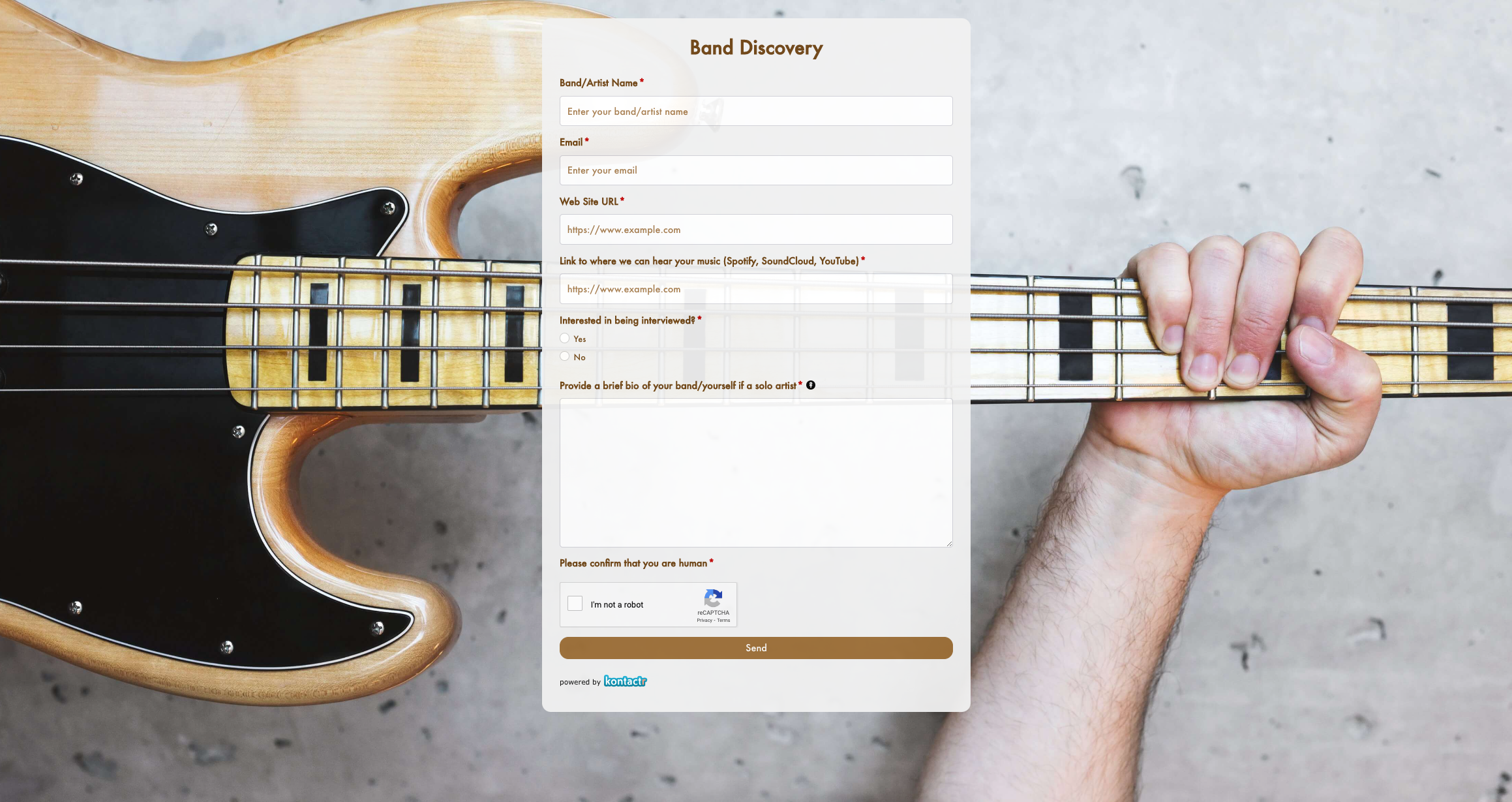 Band Discovery Form
Band Discovery Form
 Book a room Form
Book a room Form
 Booking Enquiries Form
Booking Enquiries Form
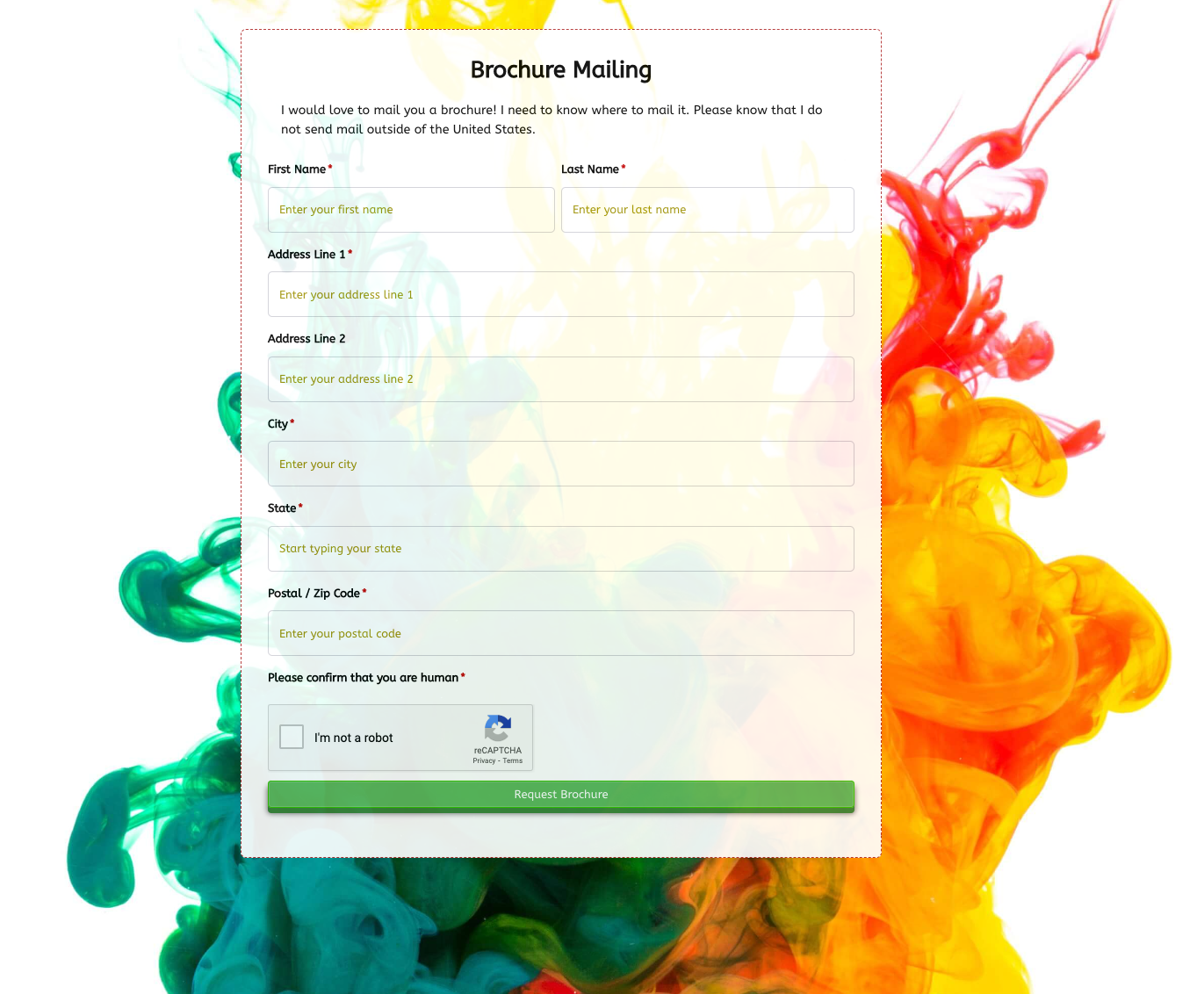 Brochure Mailing Form
Brochure Mailing Form
 Buy a Home Form
Buy a Home Form
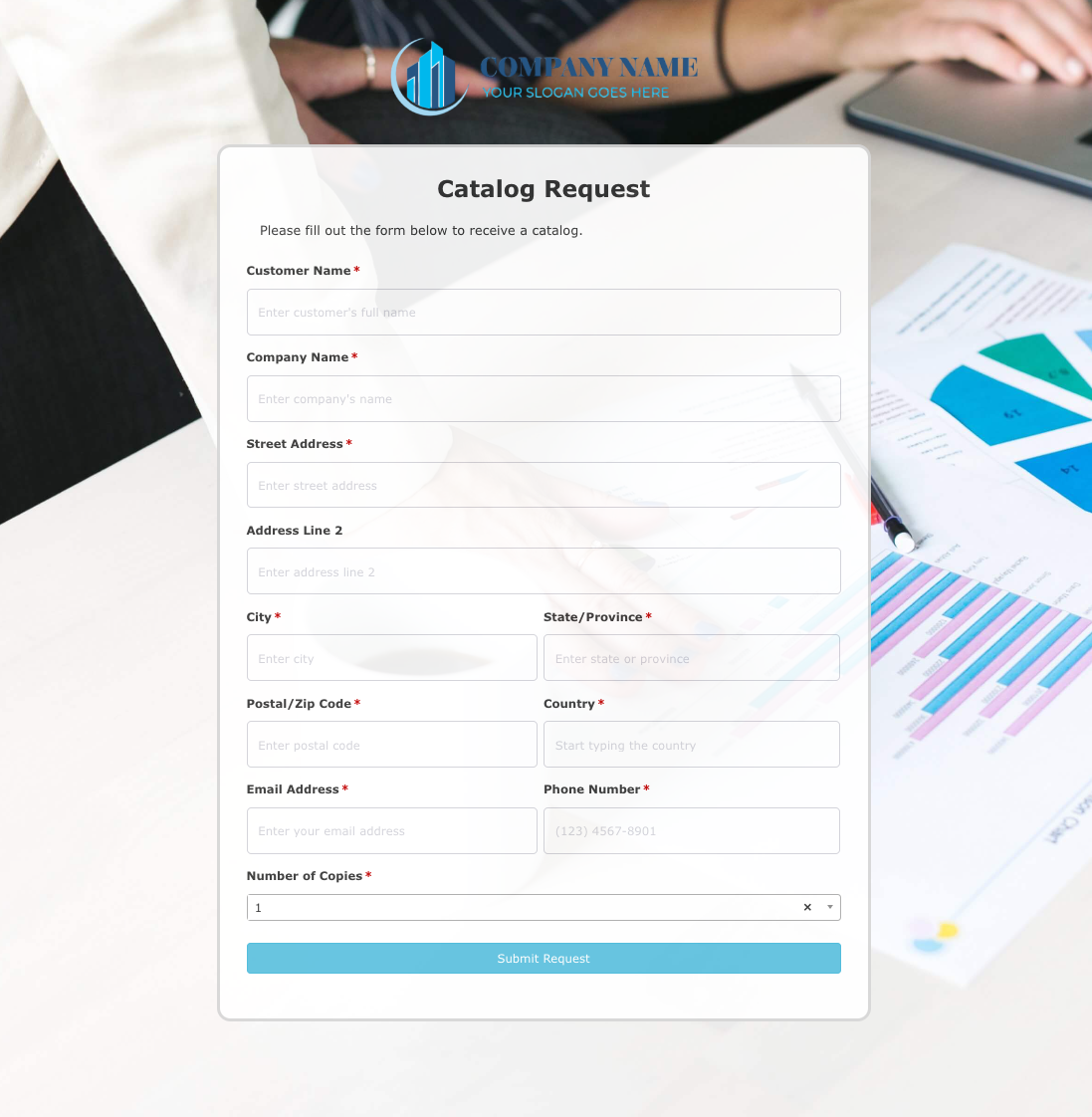 Catalog Request Form
Catalog Request Form
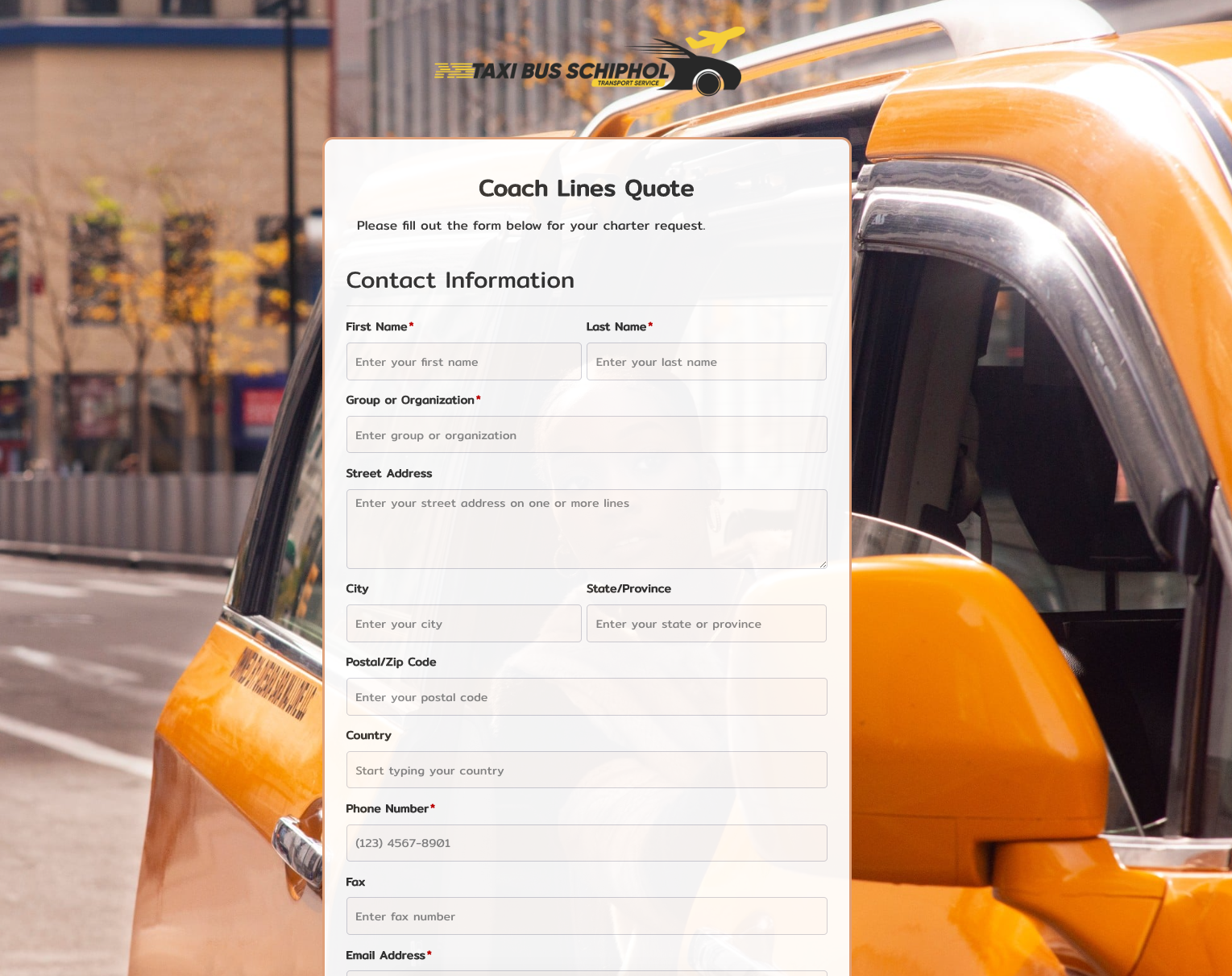 Coach Lines Quote Form
Coach Lines Quote Form
 Contact Us Form
Contact Us Form
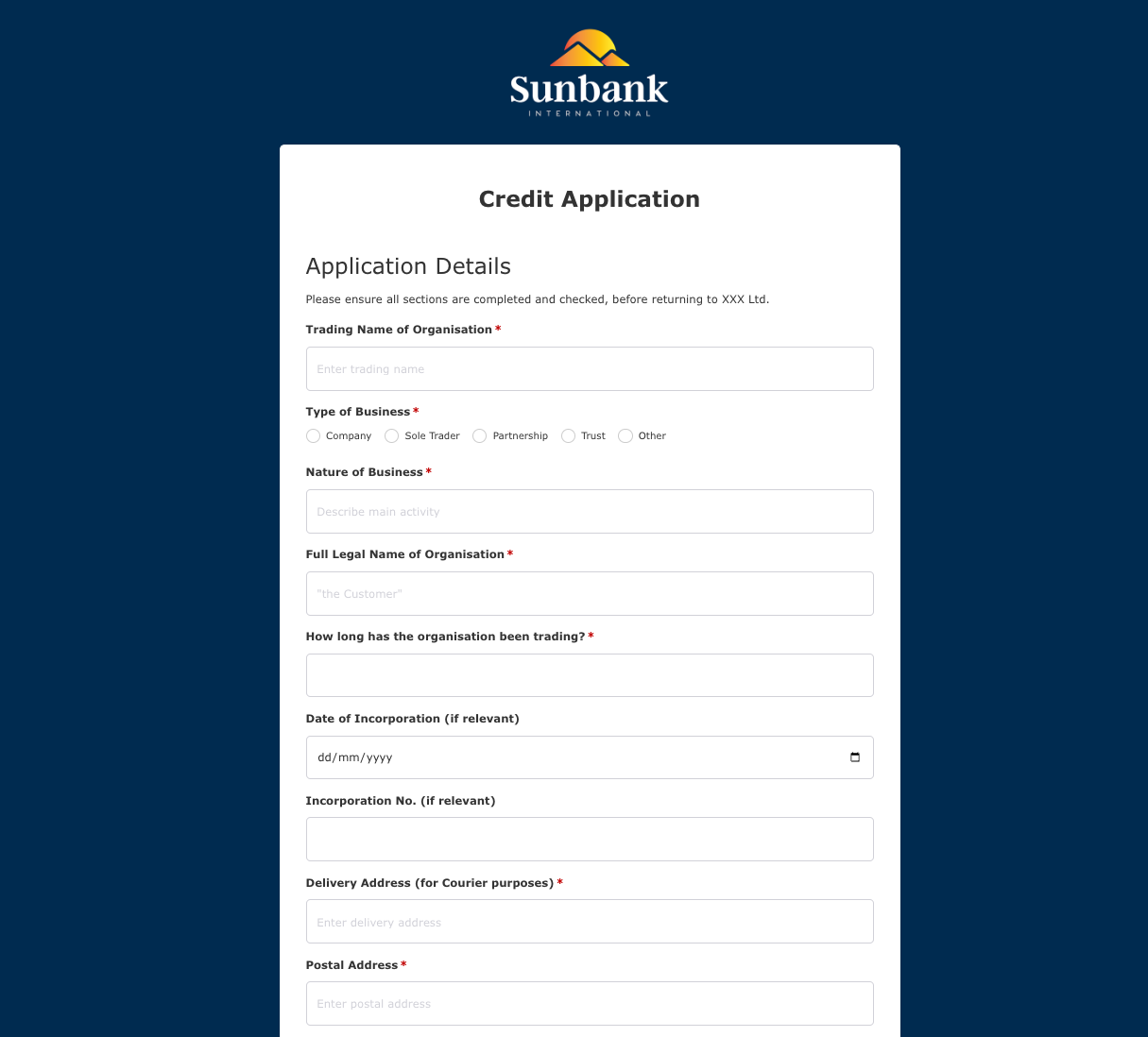 Credit Application Form
Credit Application Form
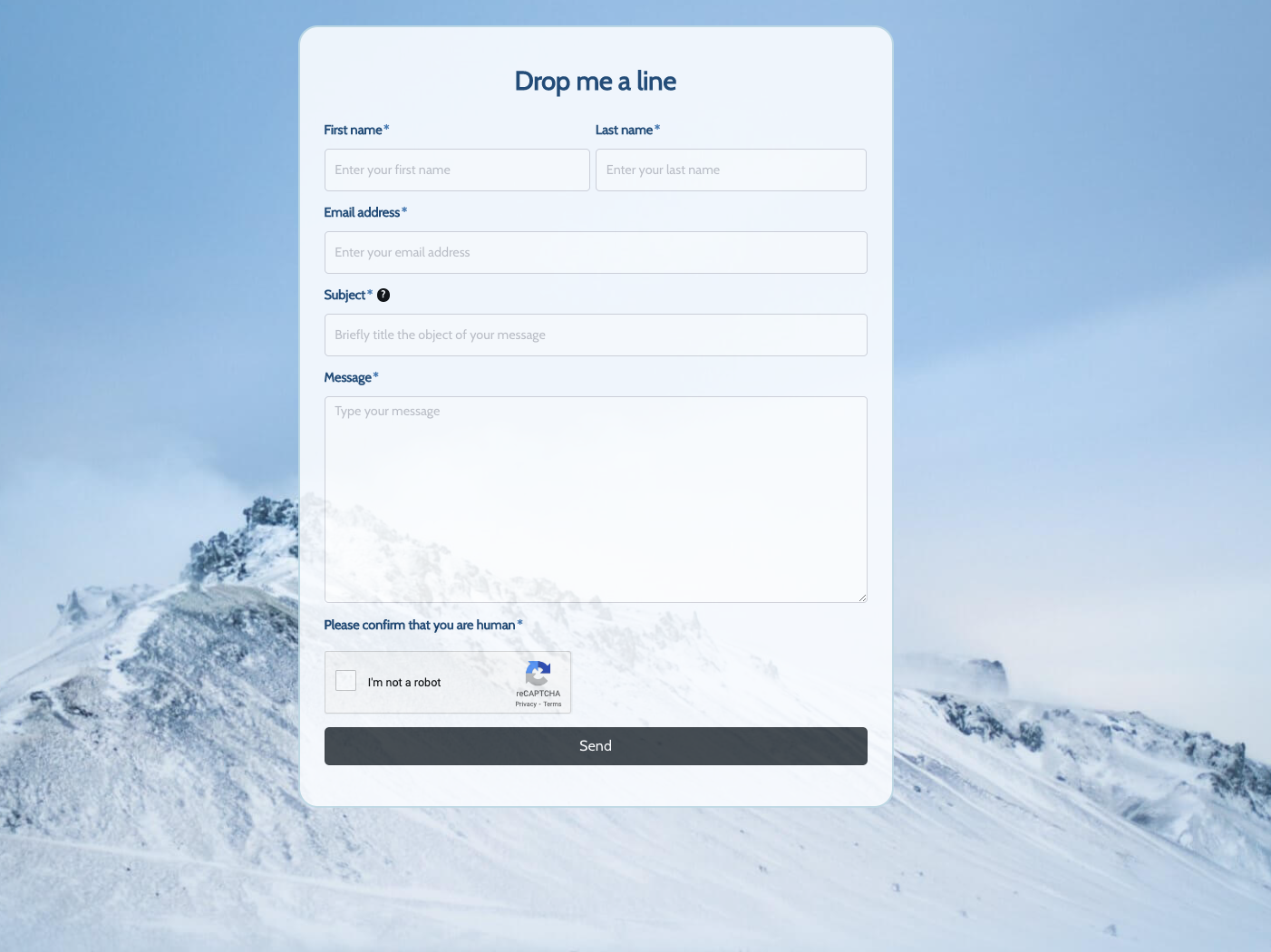 Drop me a line Form
Drop me a line Form
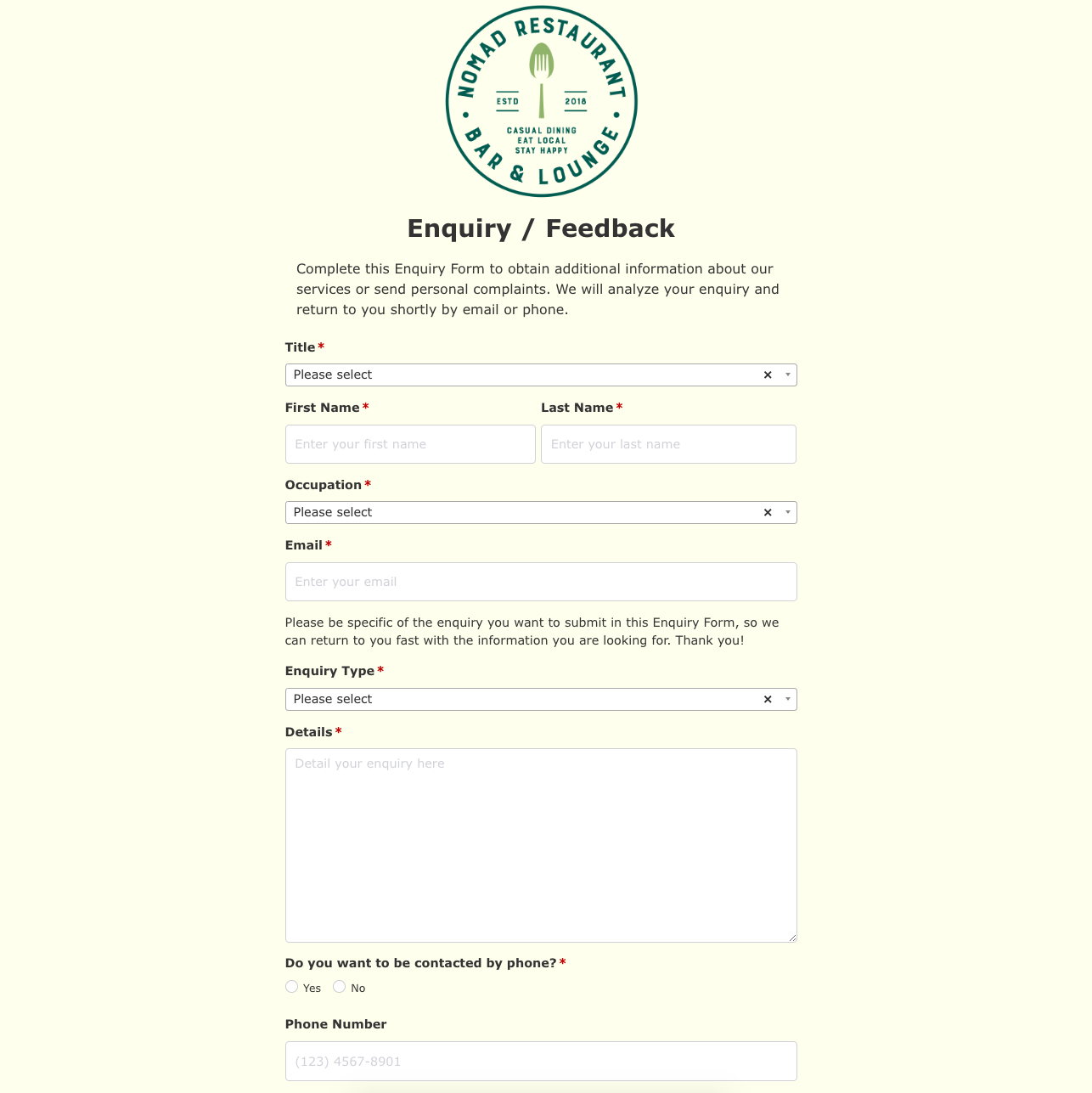 Enquiry / Feedback Form
Enquiry / Feedback Form
 Got a question? Form
Got a question? Form
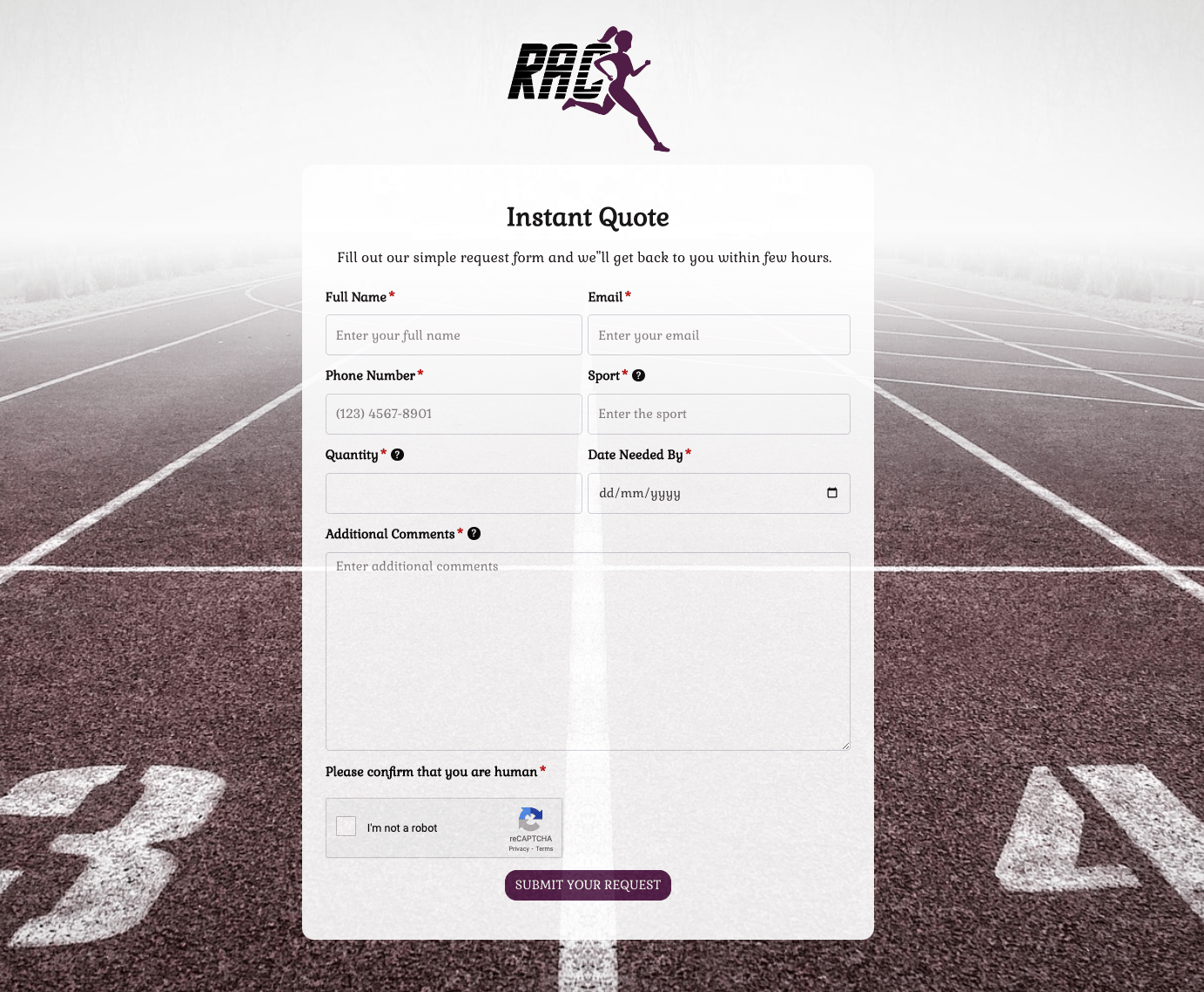 Instant Quote Form
Instant Quote Form
 Job Application Form
Job Application Form
 Language & Literacy Lab Form
Language & Literacy Lab Form
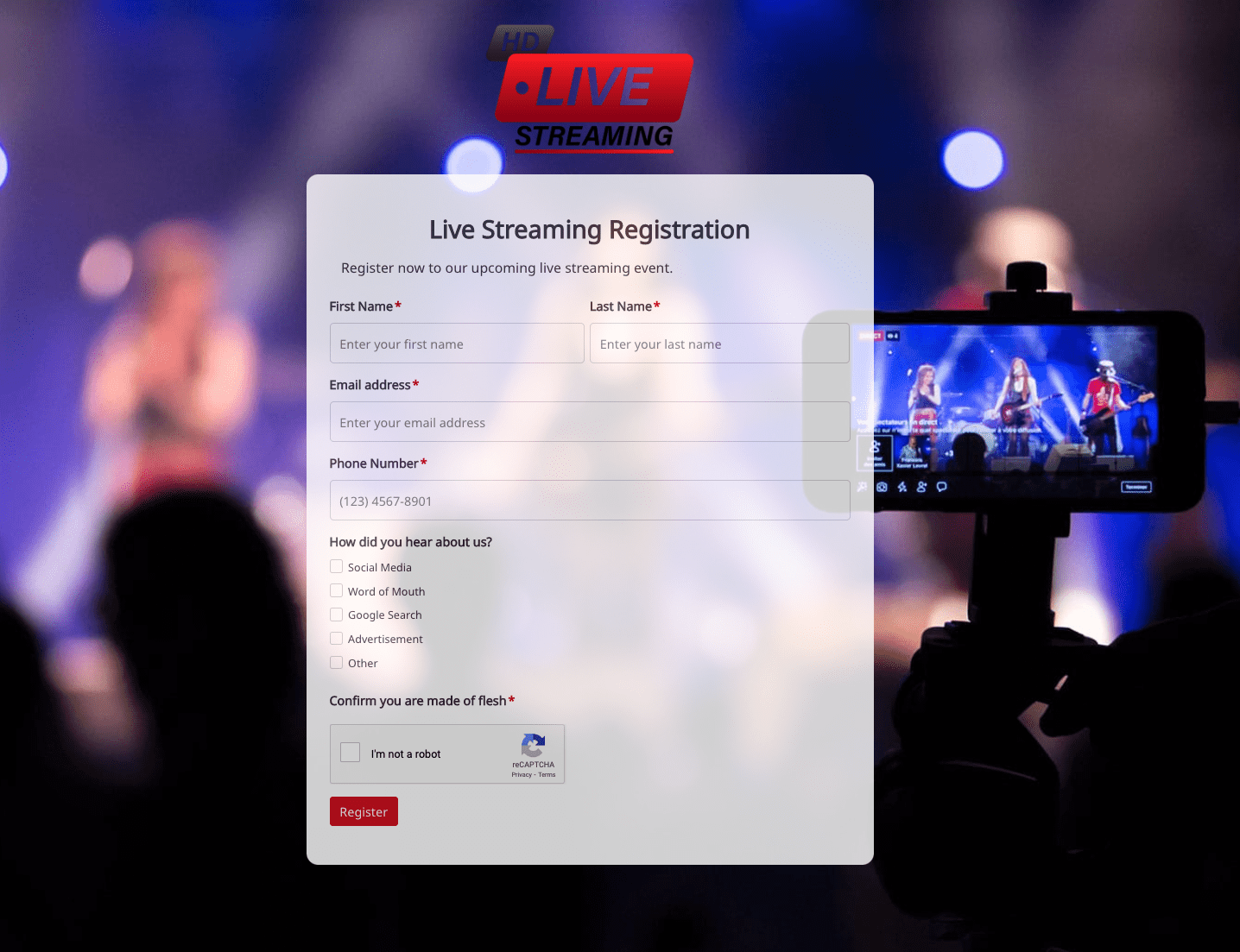 Live Streaming Registration Form
Live Streaming Registration Form
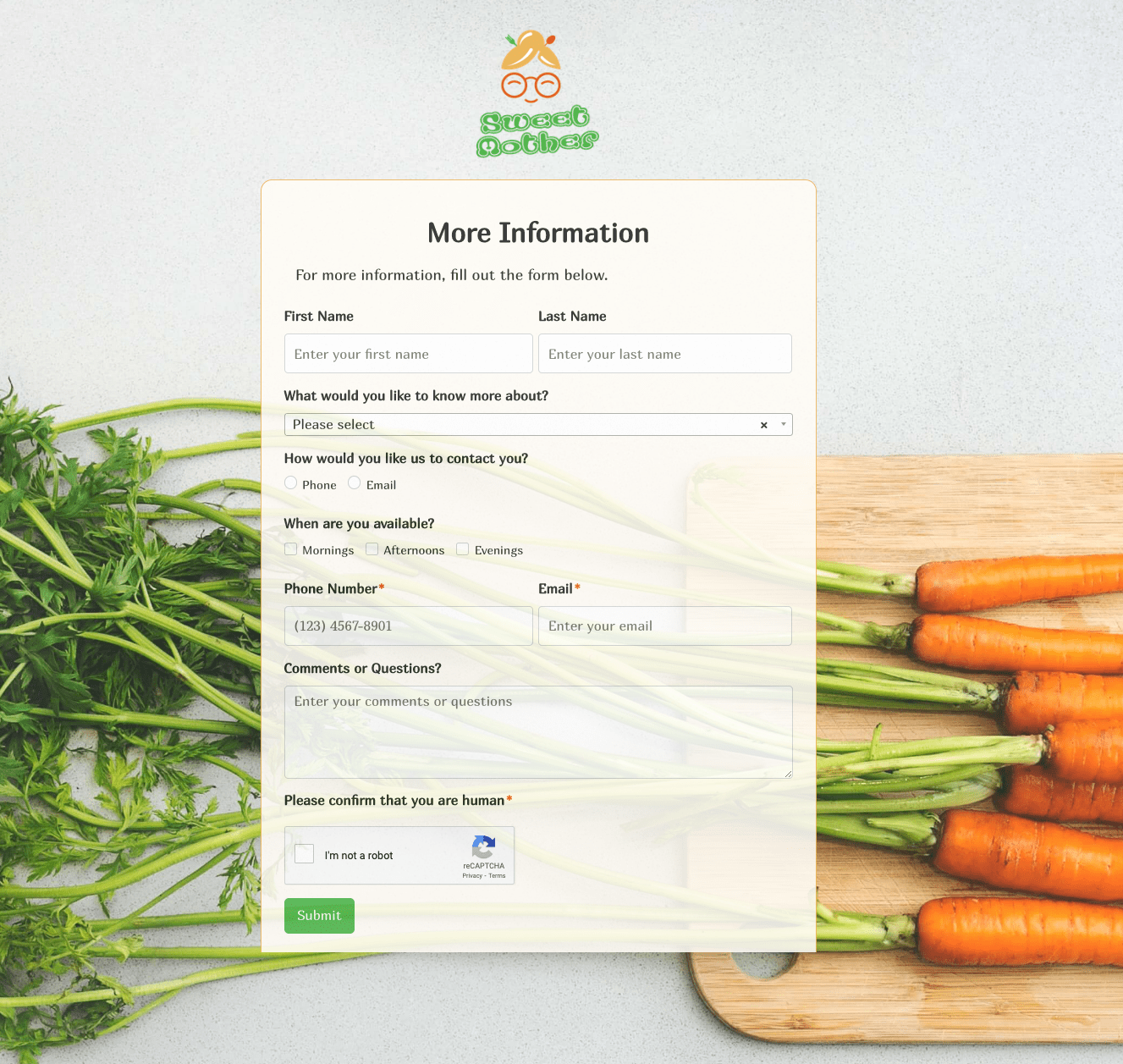 More Information Form
More Information Form
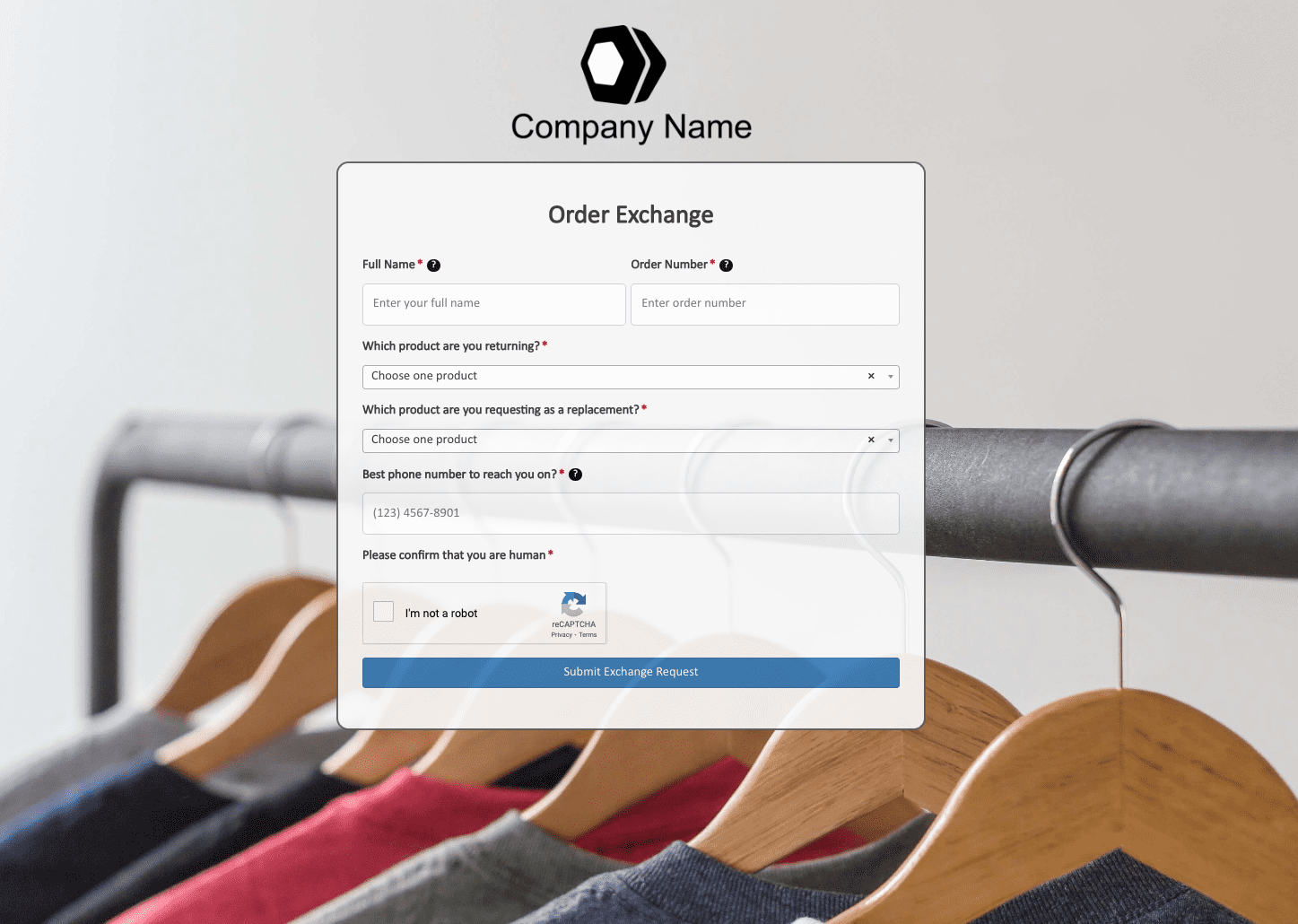 Order Exchange Form
Order Exchange Form
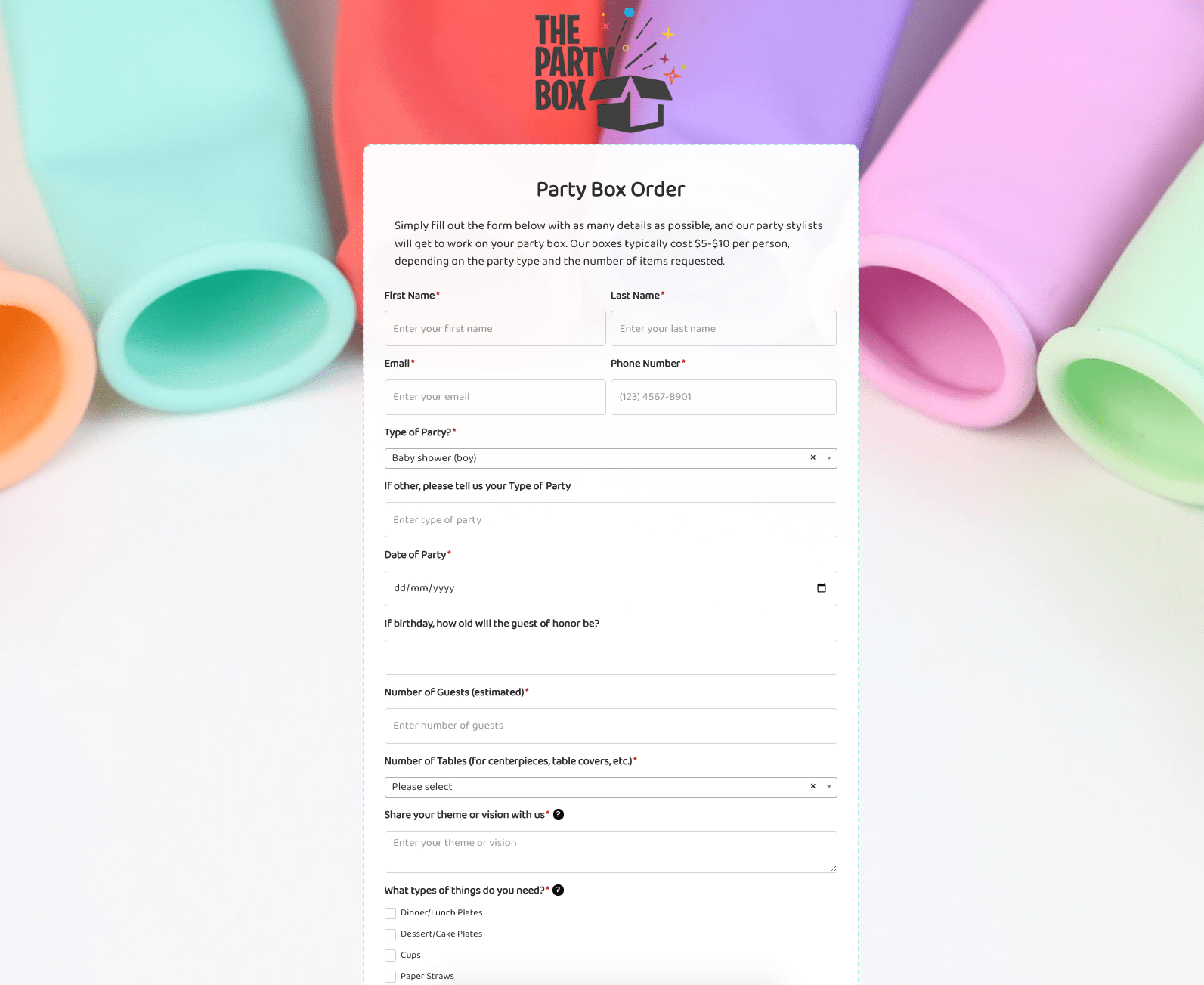 Party Box Order Form
Party Box Order Form
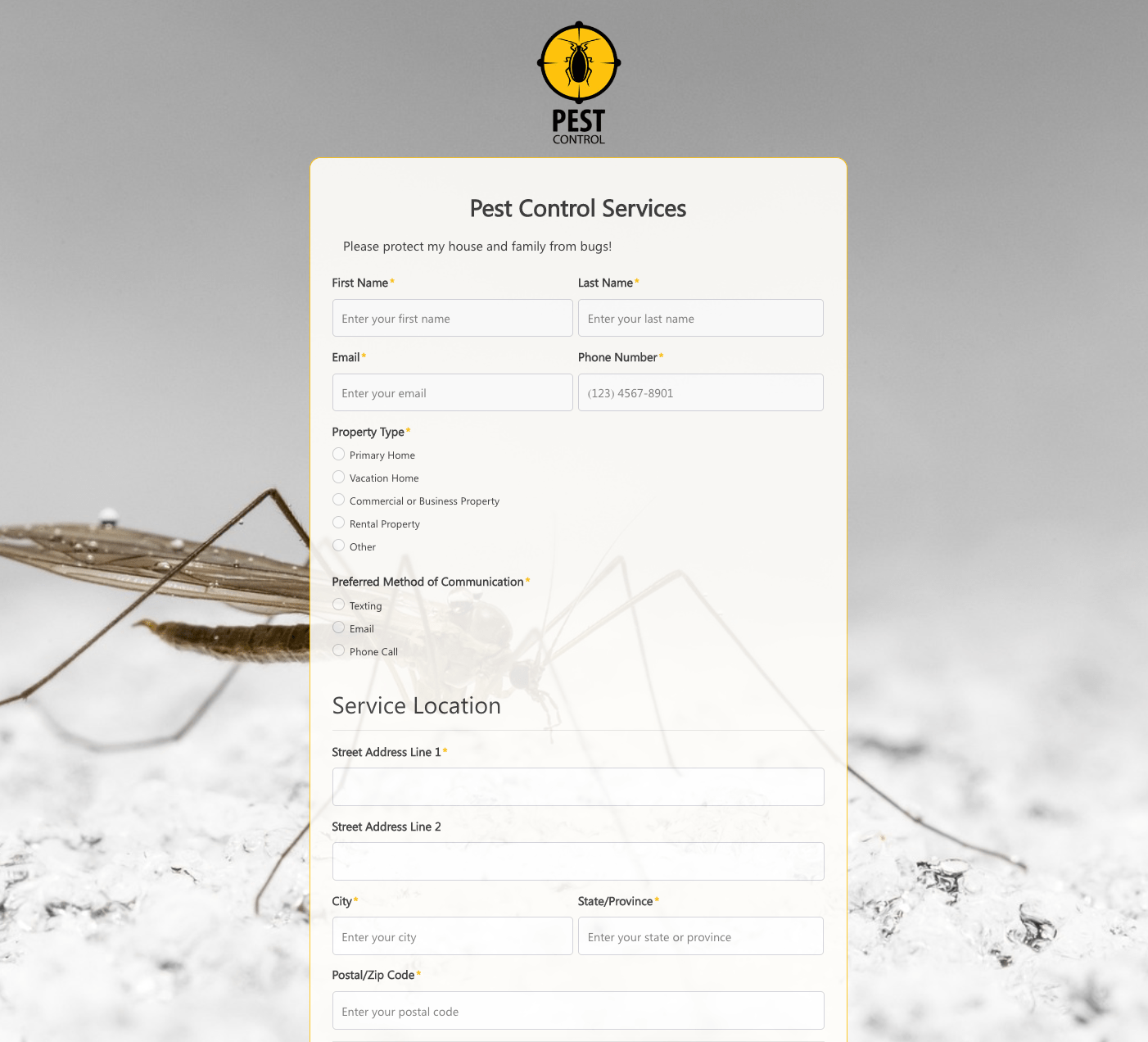 Pest Control Services Form
Pest Control Services Form
 Poll / Survey Form
Poll / Survey Form
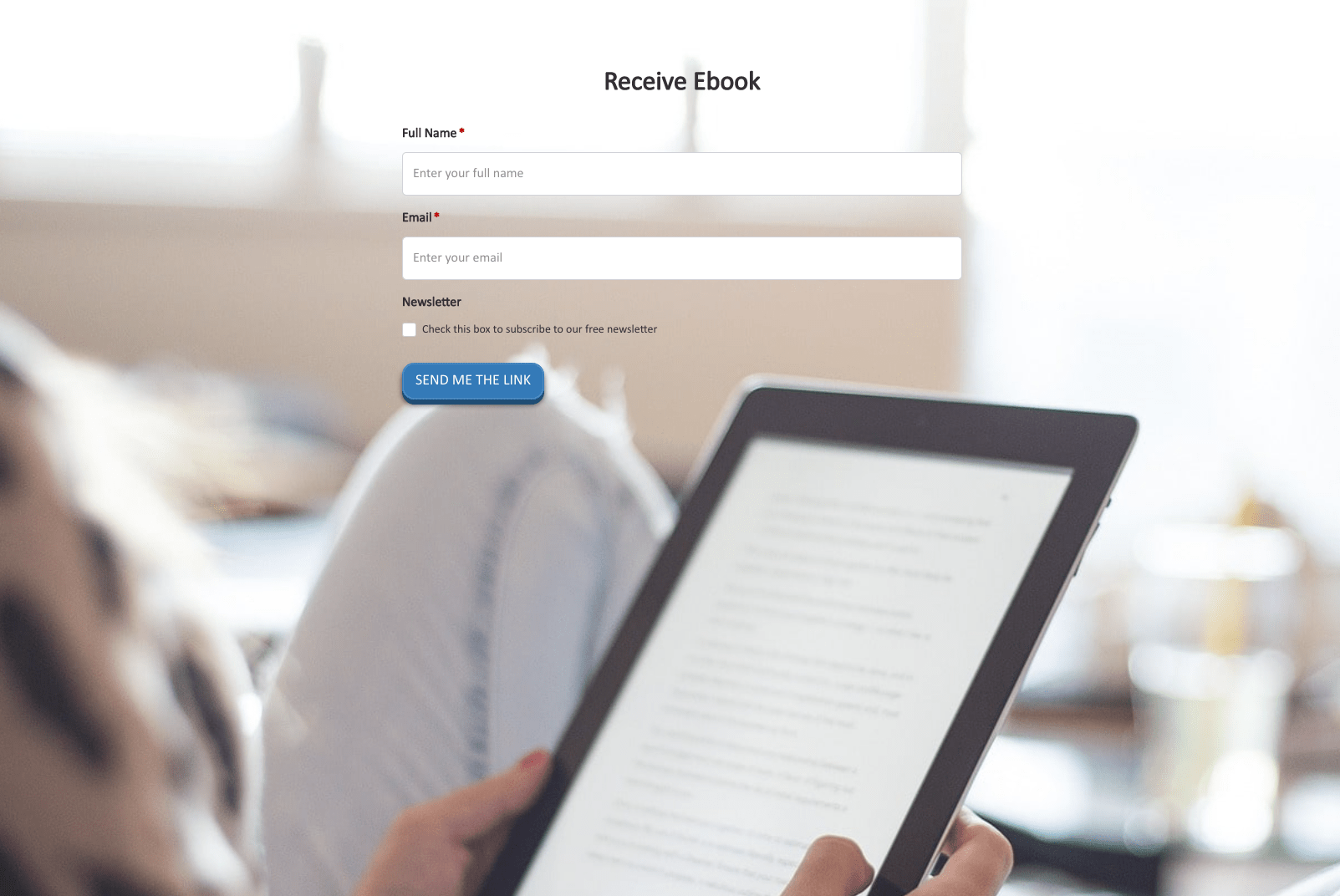 Receive Ebook Form
Receive Ebook Form
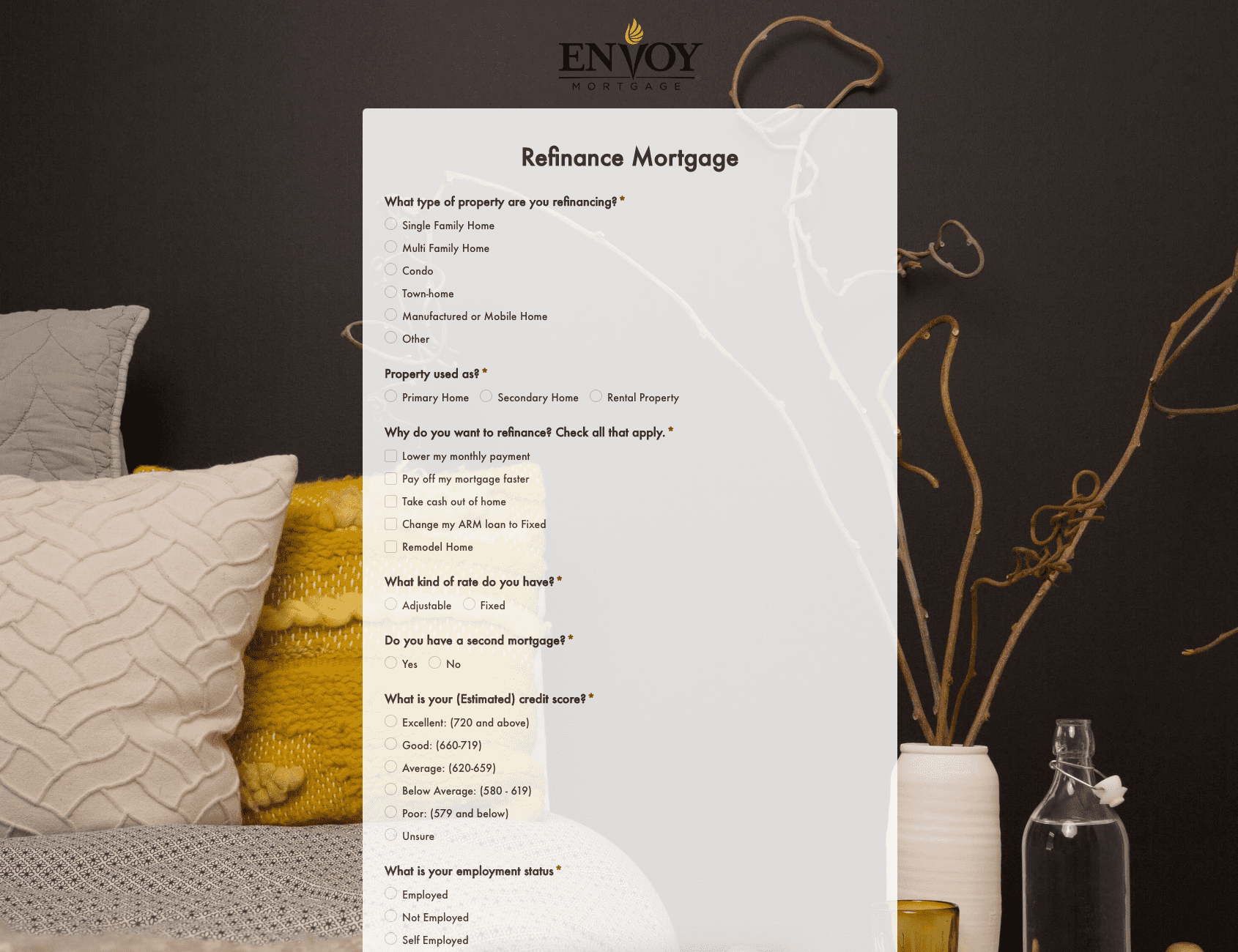 Refinance Mortgage Form
Refinance Mortgage Form
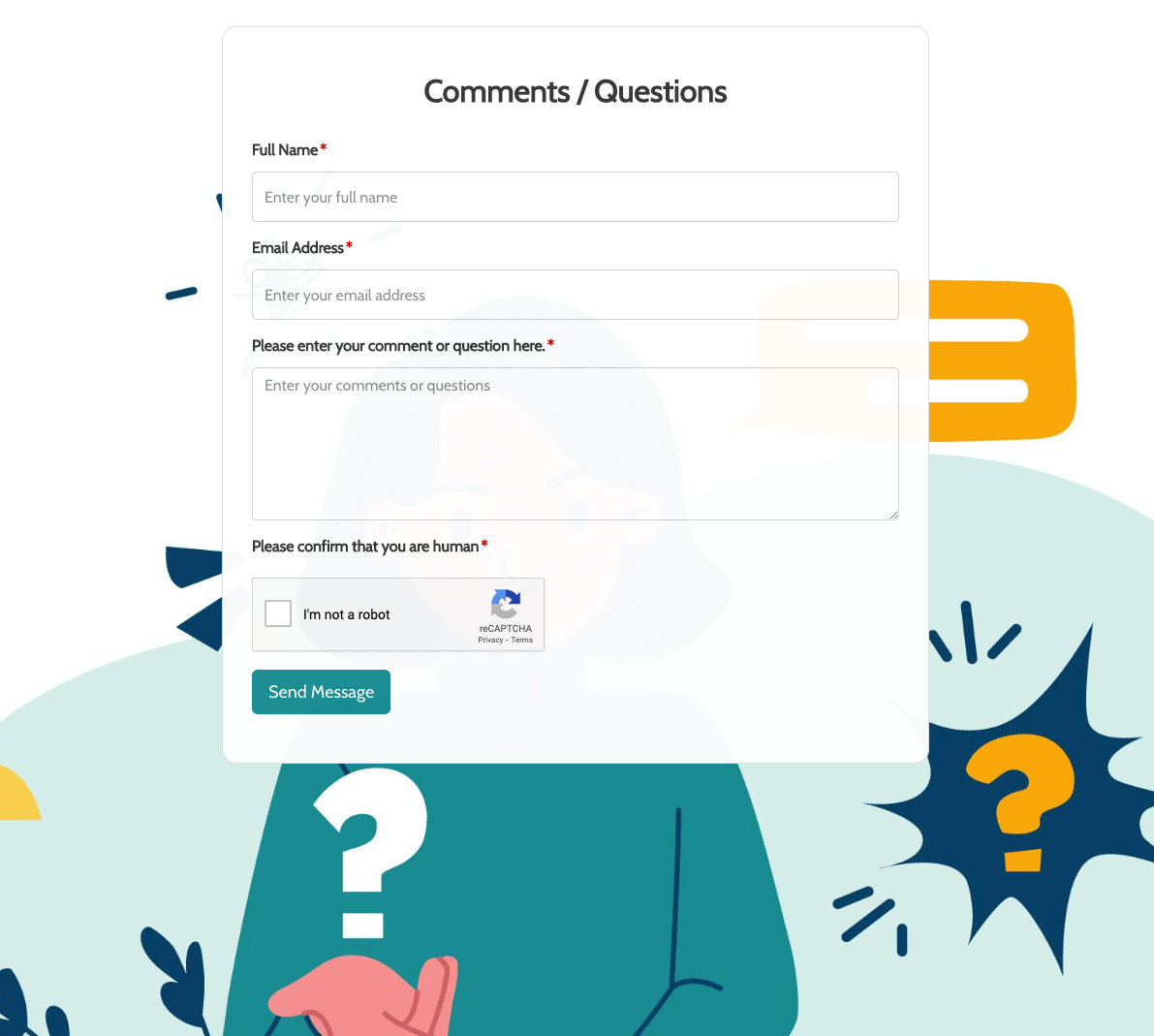 Remarks / Questions Form
Remarks / Questions Form
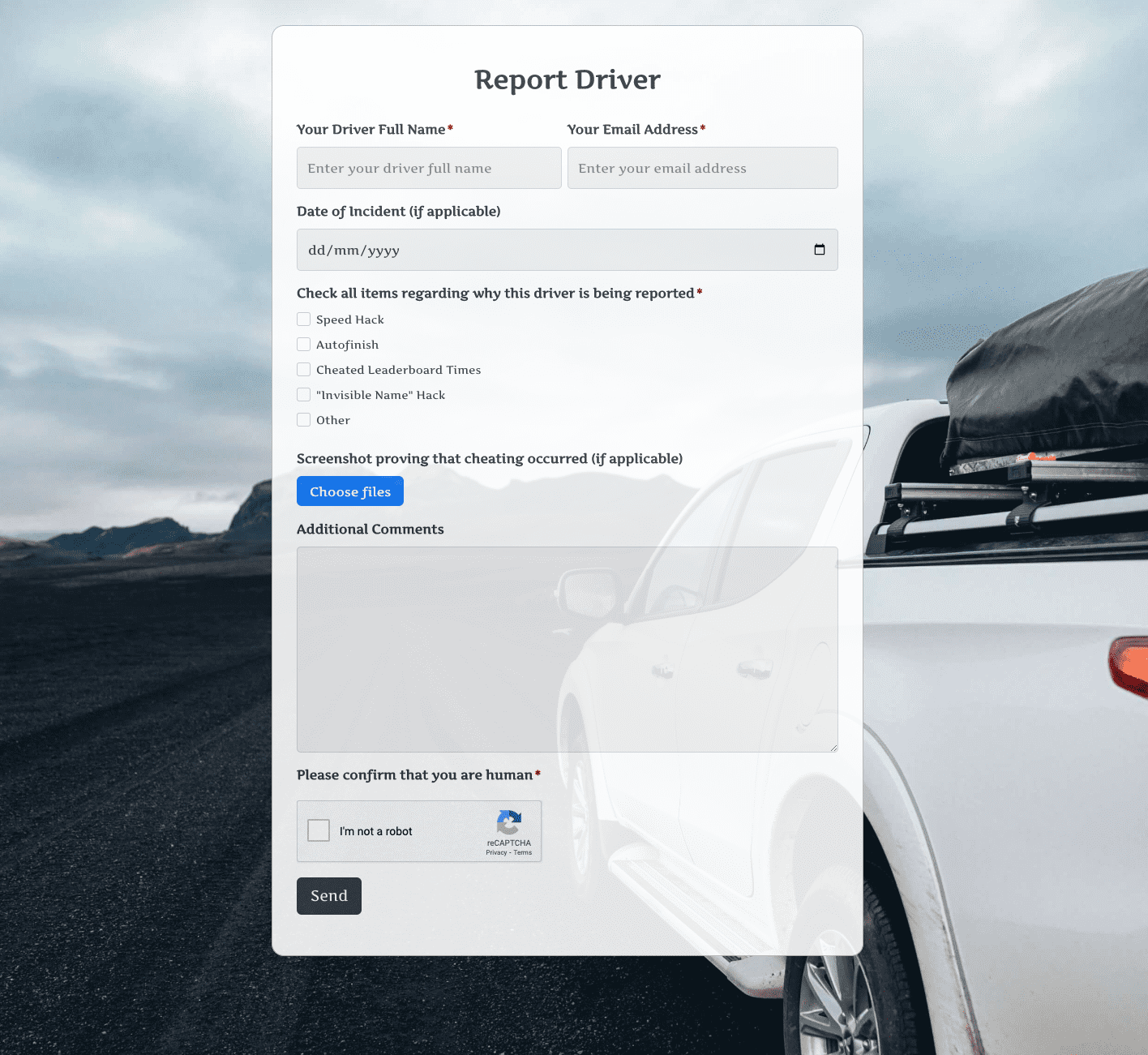 Report Driver Form
Report Driver Form
 Retreat Information Form
Retreat Information Form
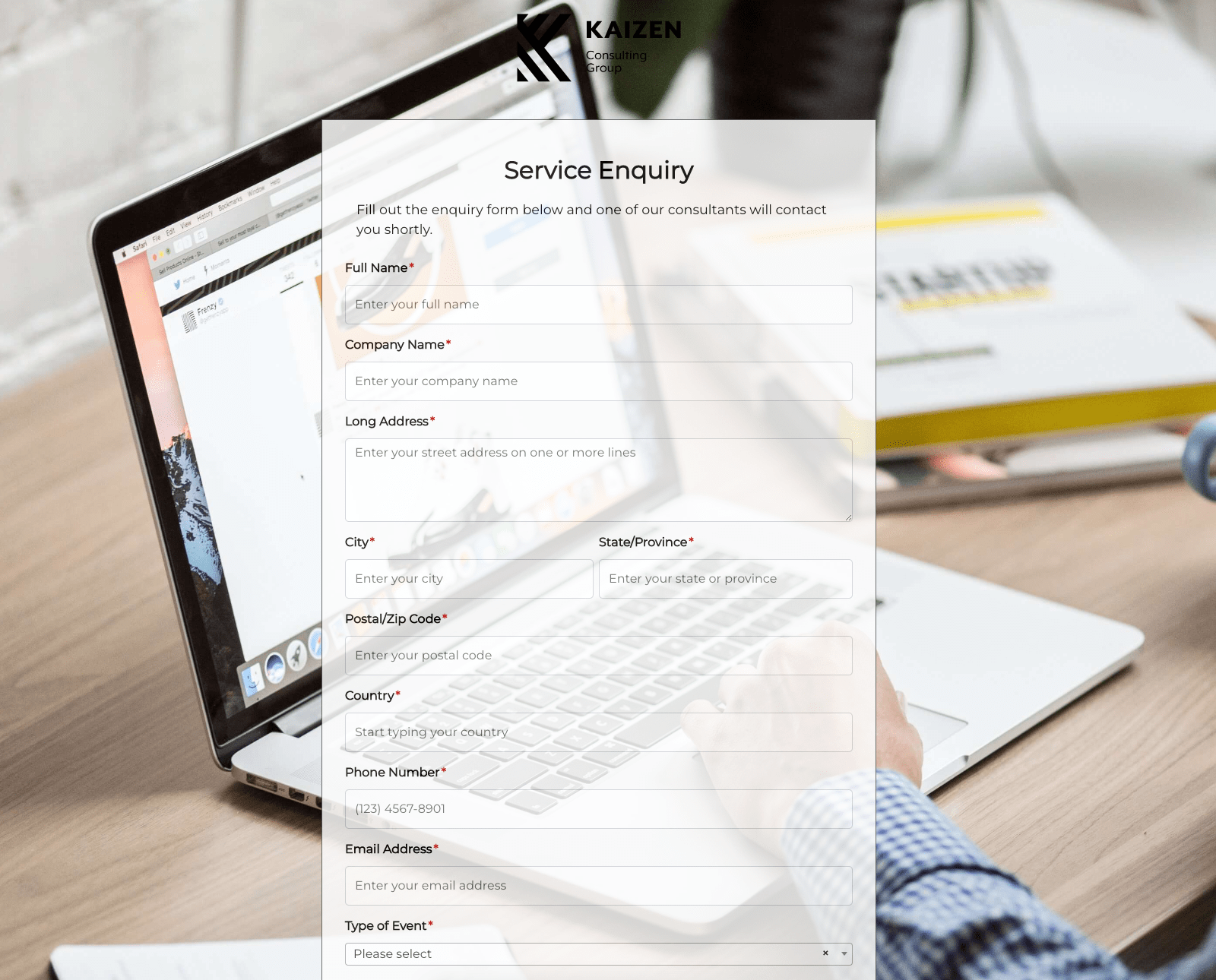 Service Enquiry Form
Service Enquiry Form
 Skydiving Registration Form
Skydiving Registration Form
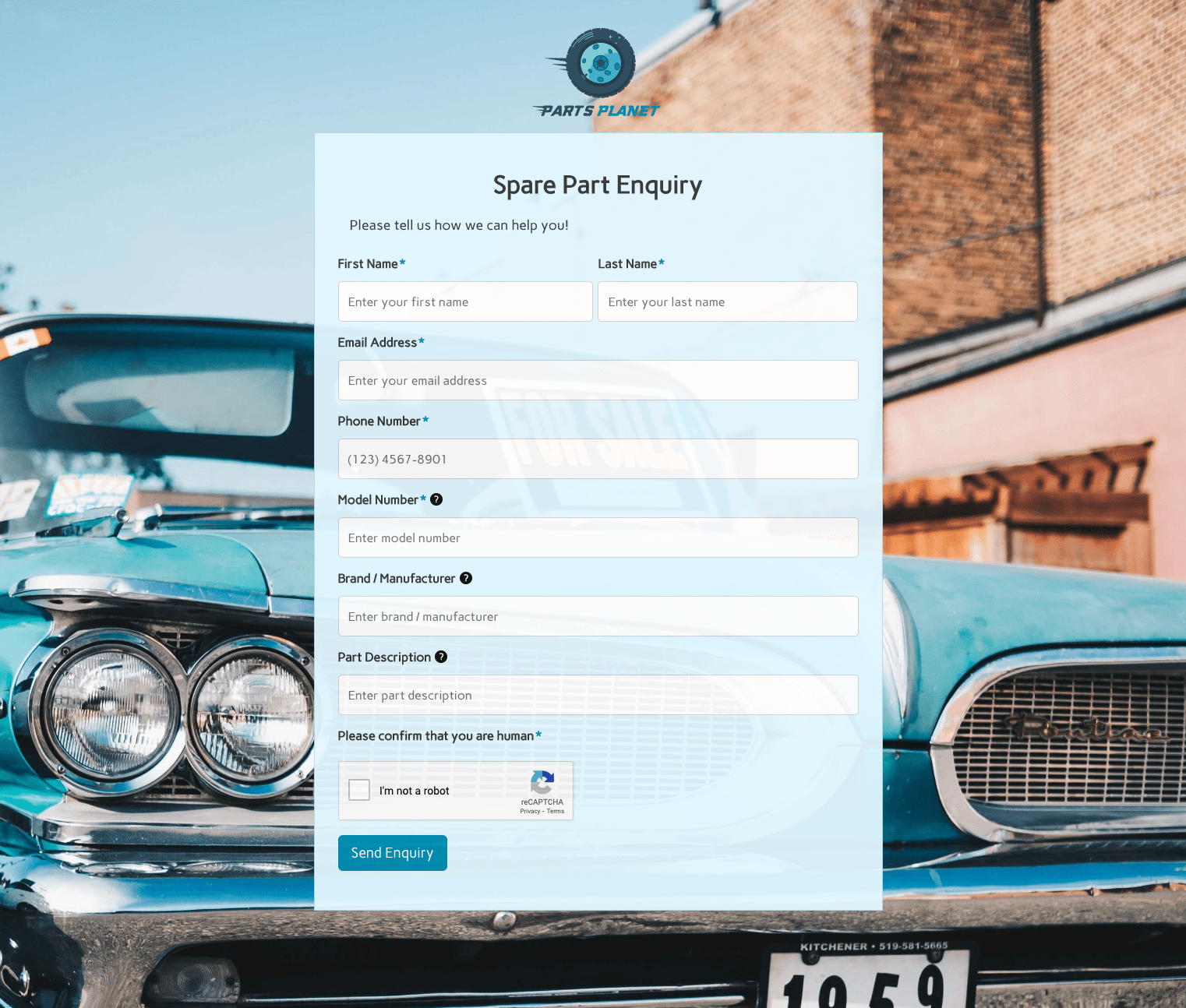 Spare Part Enquiry Form
Spare Part Enquiry Form
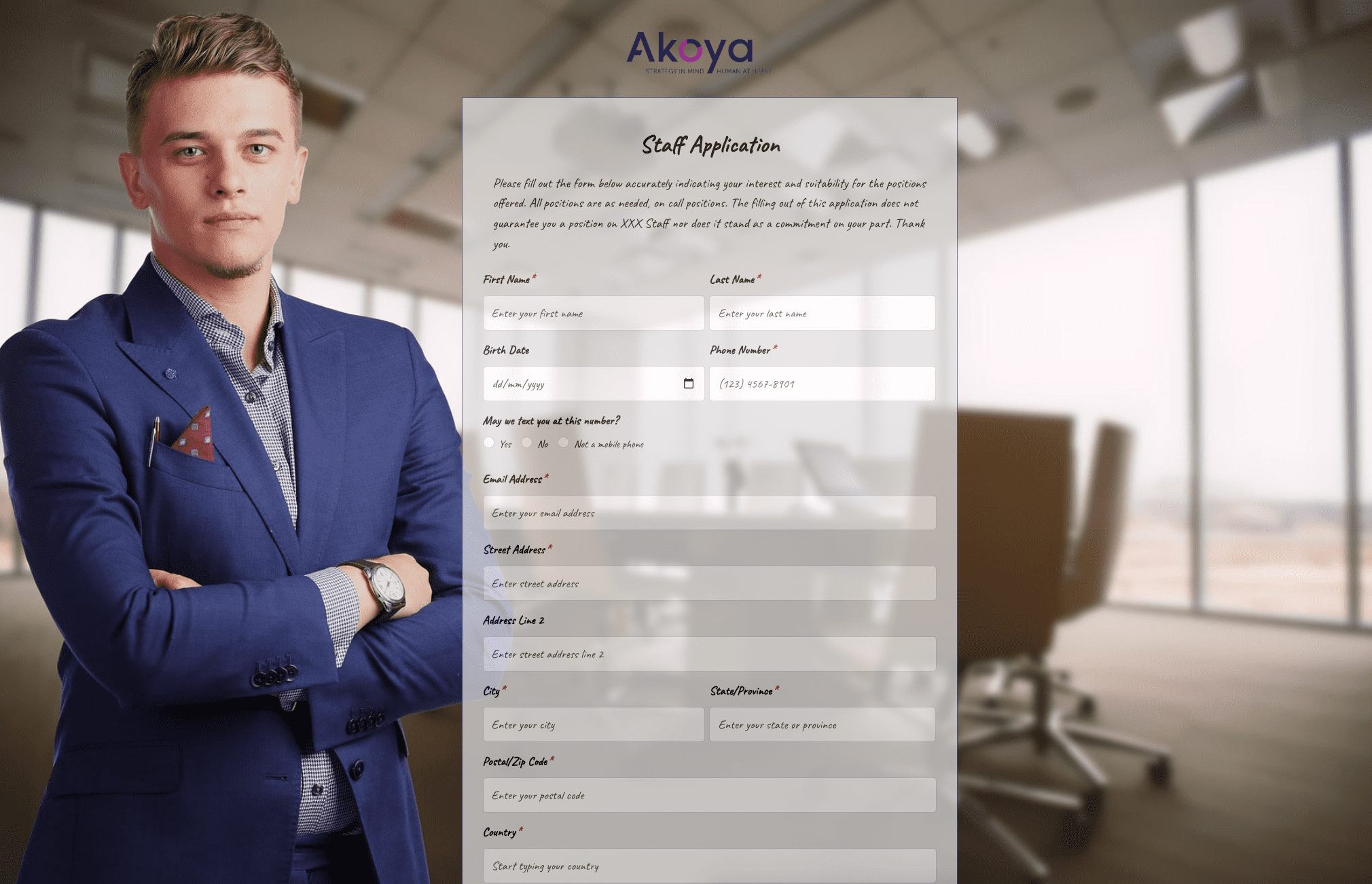 Staff Application Form
Staff Application Form
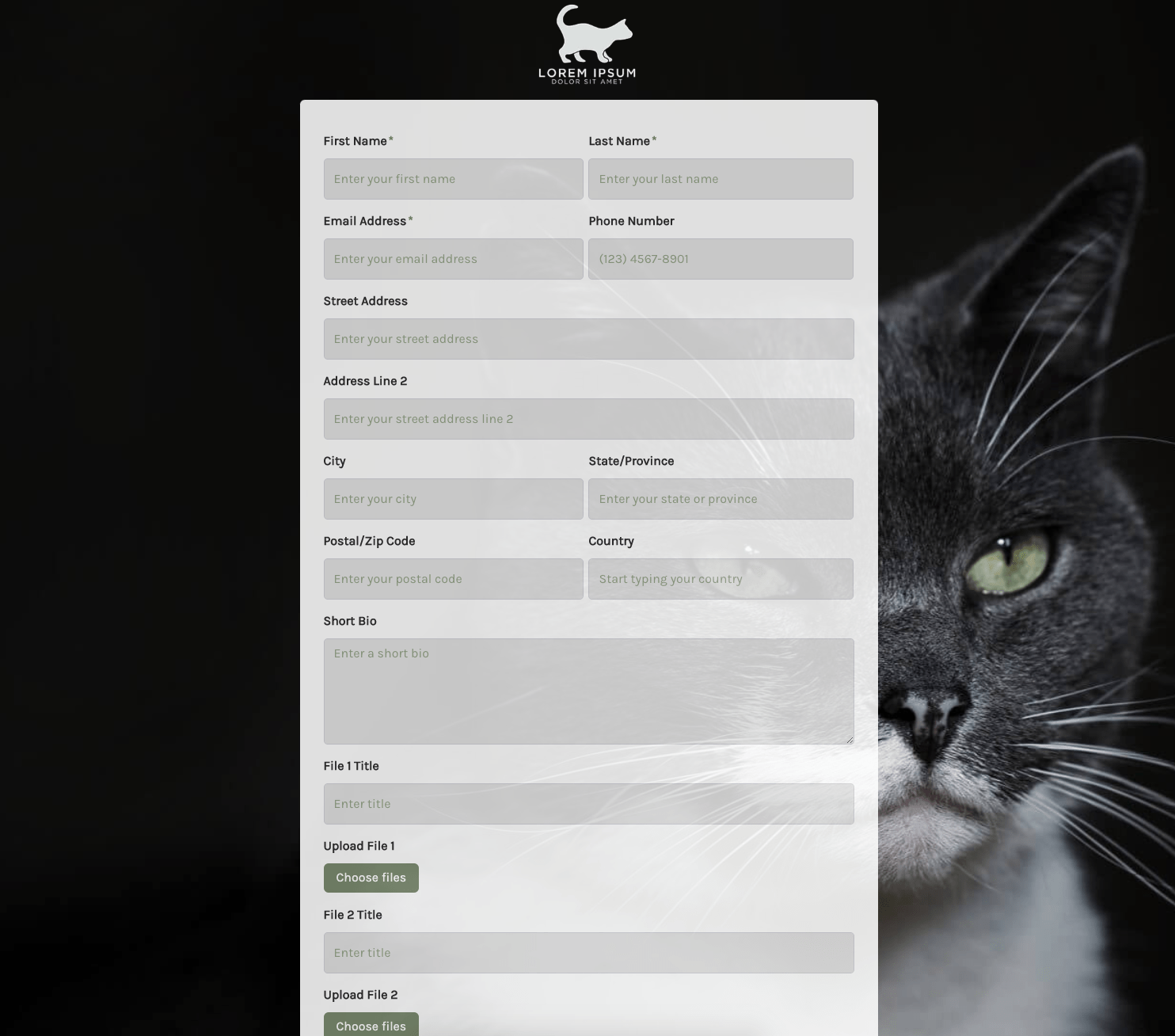 Submission Form
Submission Form
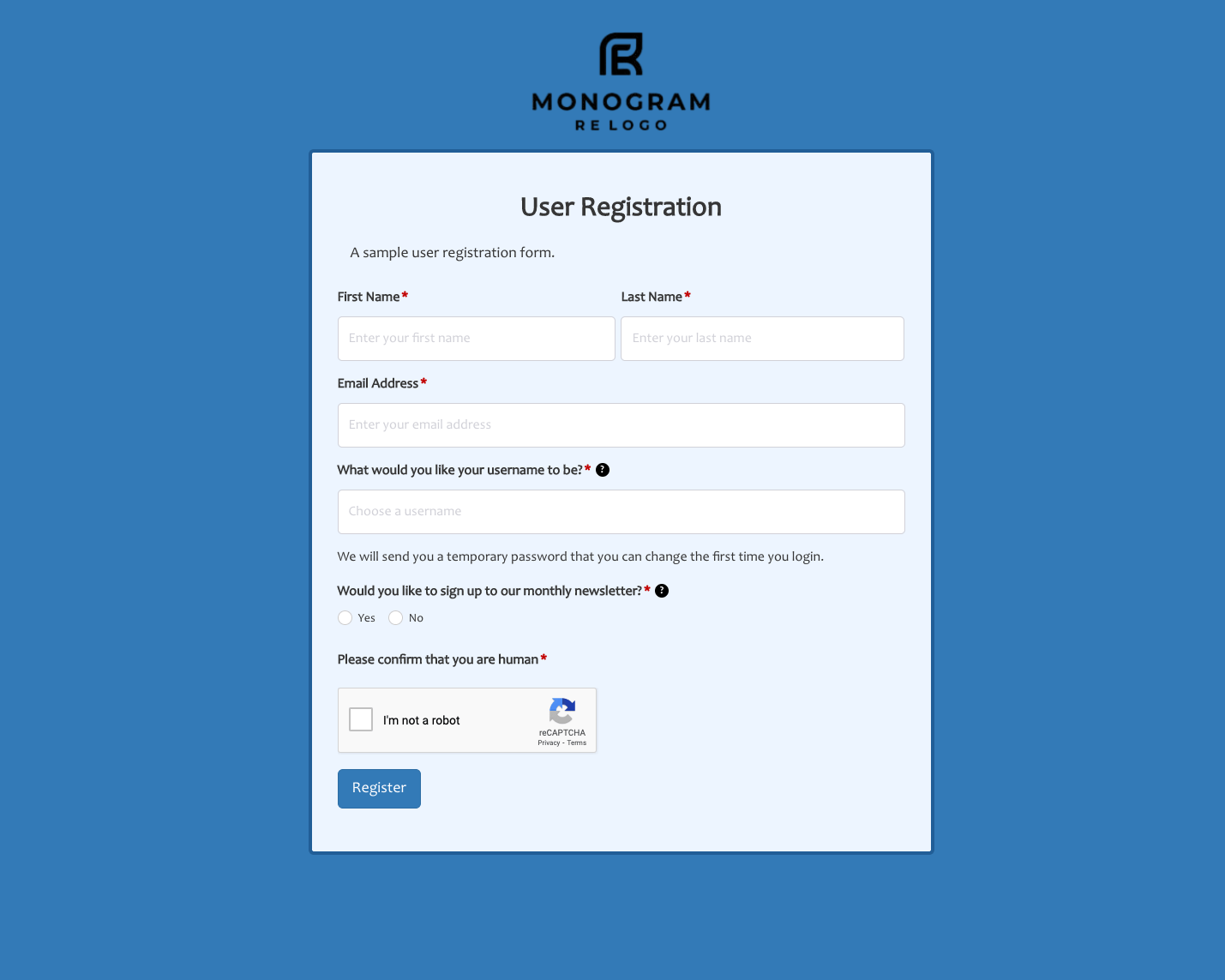 User Registration Form
User Registration Form
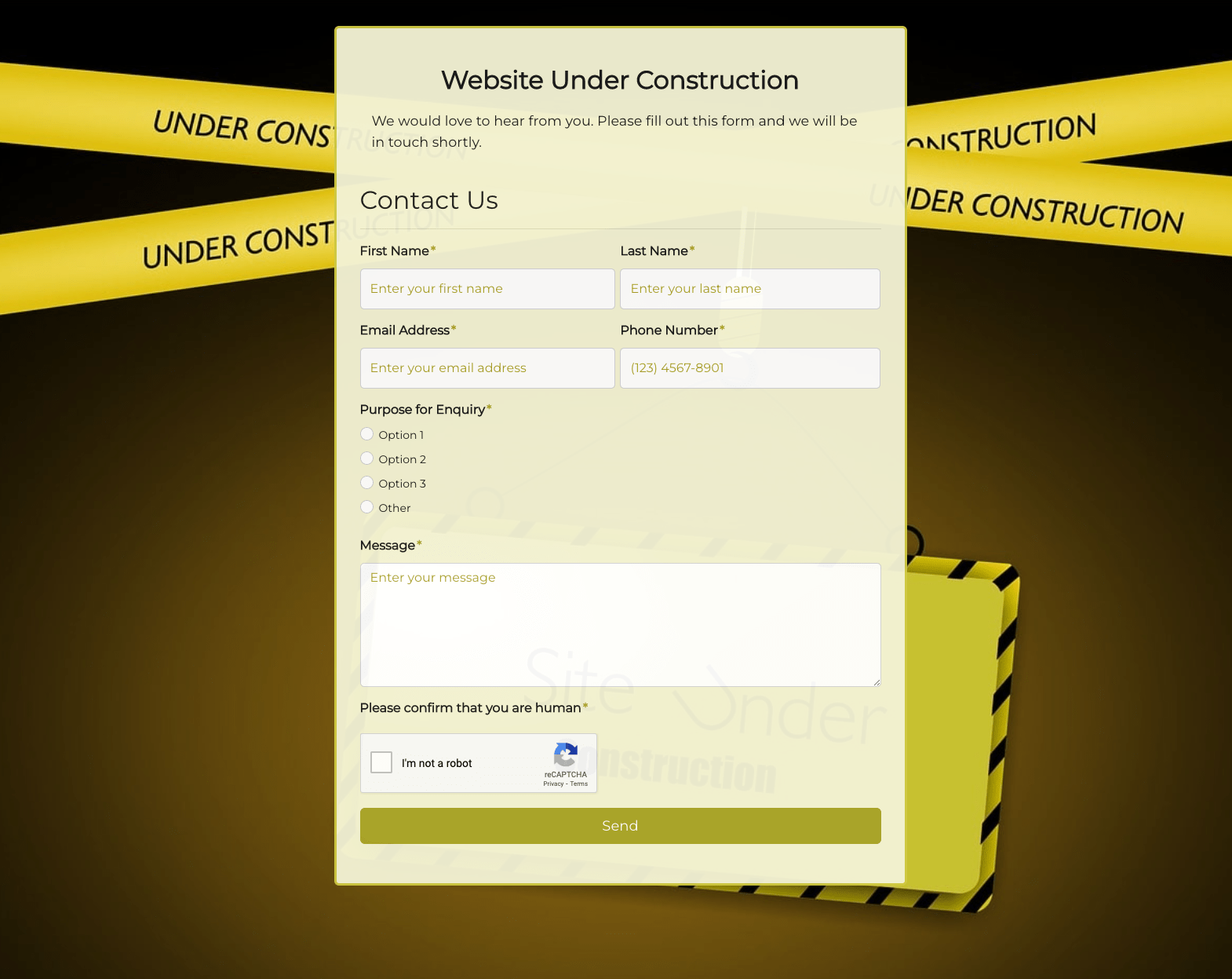 Website Under Construction Form
Website Under Construction Form
 Wedding Photographer Form
Wedding Photographer Form
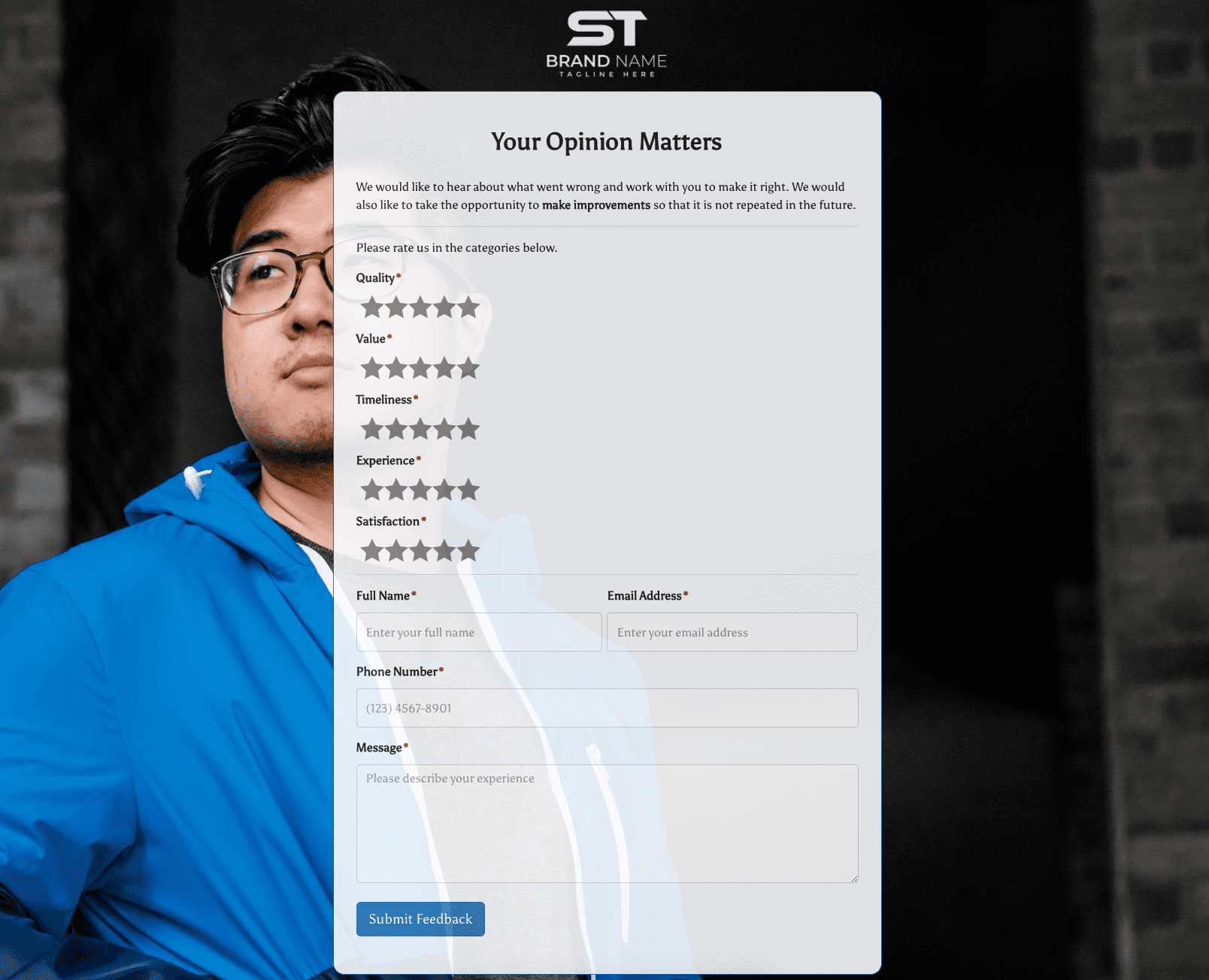 Your Opinion Matters Form
Your Opinion Matters Form






















